Inclusive Education: Global Perspectives
VerifiedAdded on 2020/04/01
|21
|5955
|68
AI Summary
This assignment delves into the complexities of inclusive education by comparing and contrasting its implementation in Canada and Zimbabwe. It analyzes various perspectives on inclusive education, encompassing theoretical frameworks, practical applications, policy considerations, and the experiences of teachers, students, and families. The assignment draws upon a diverse range of resources, including research papers, reports, and policy documents, to provide a comprehensive understanding of the current state and future directions of inclusive education in these two countries.
Contribute Materials
Your contribution can guide someone’s learning journey. Share your
documents today.
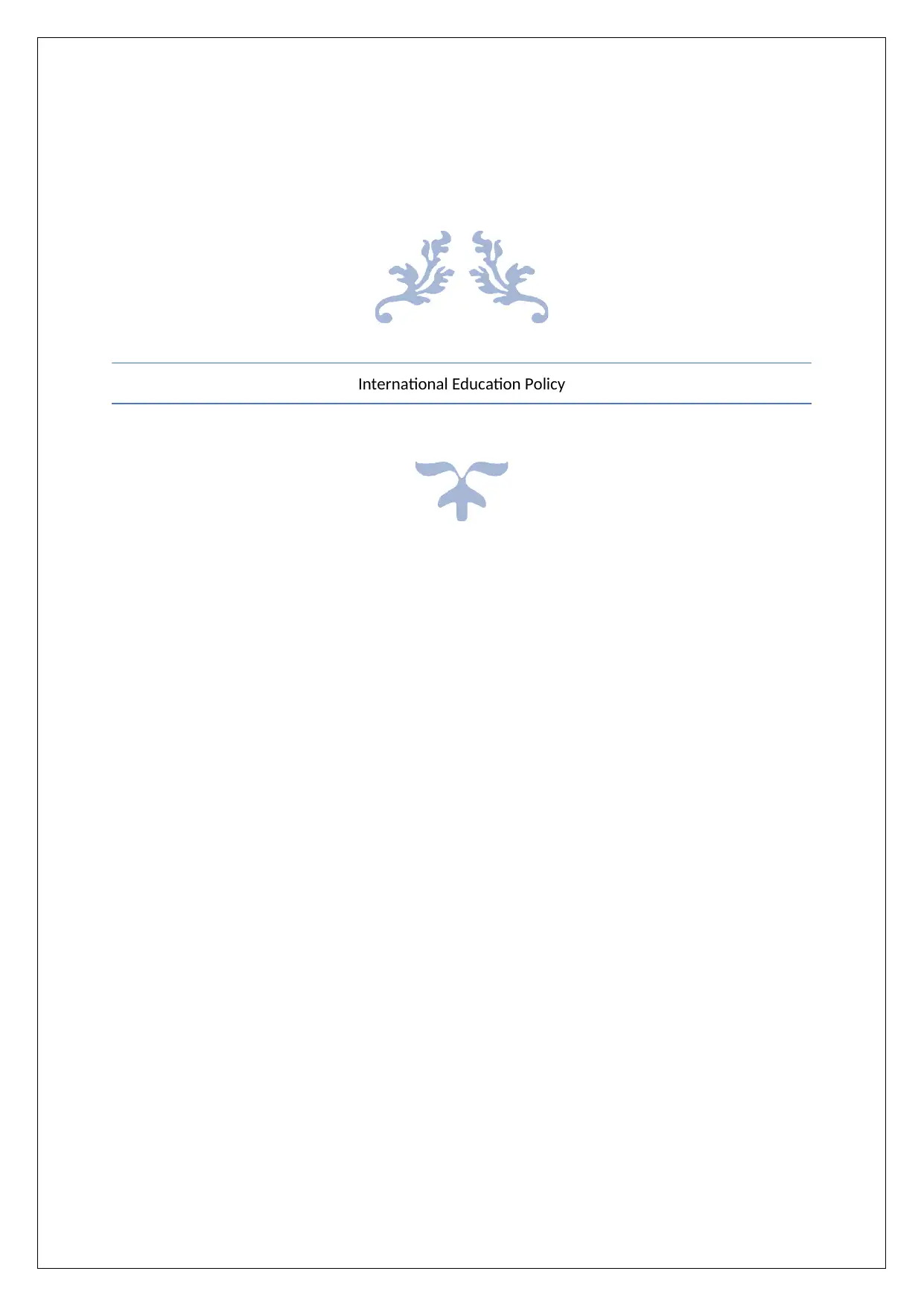
International Education Policy
Secure Best Marks with AI Grader
Need help grading? Try our AI Grader for instant feedback on your assignments.
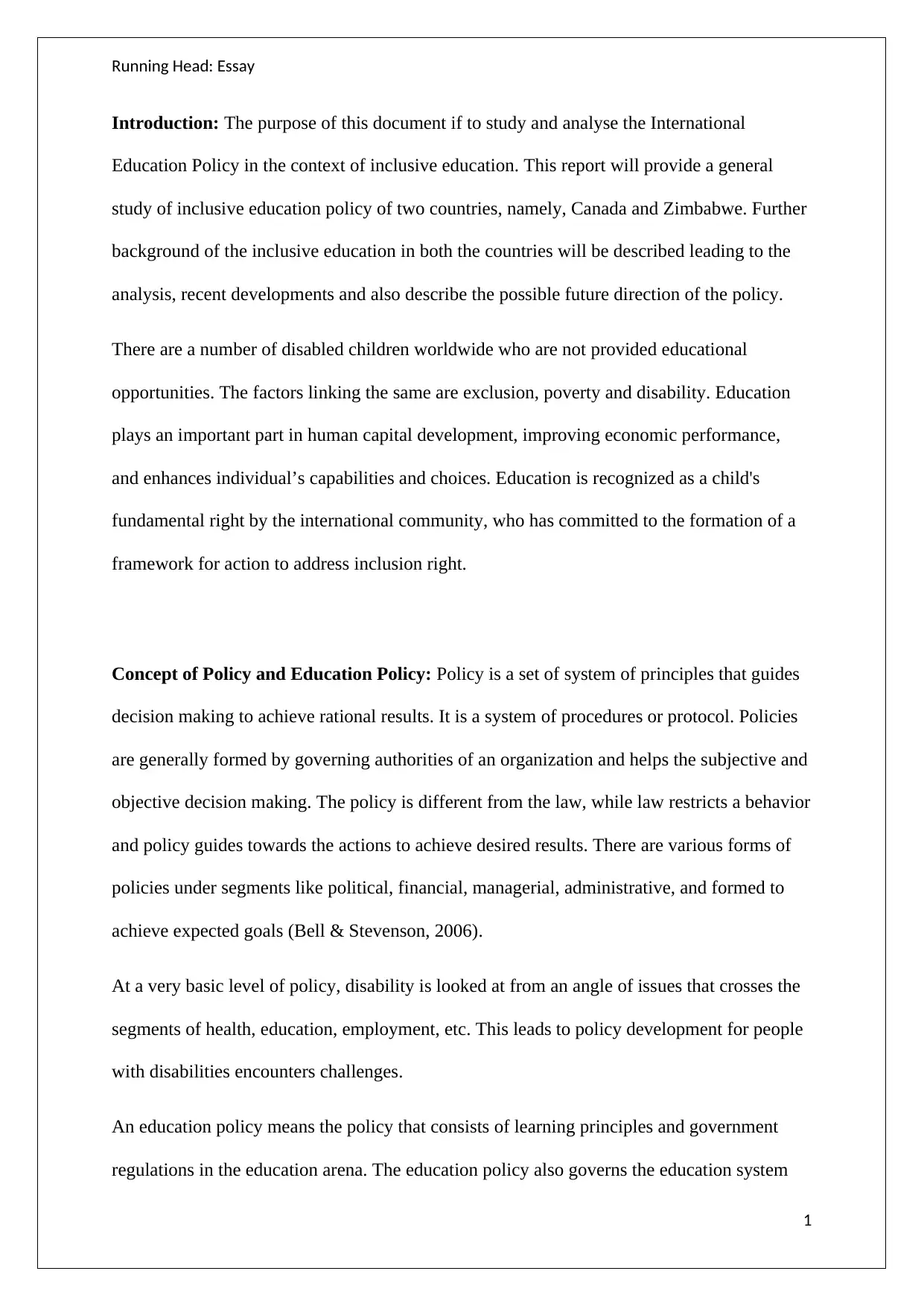
Running Head: Essay
Introduction: The purpose of this document if to study and analyse the International
Education Policy in the context of inclusive education. This report will provide a general
study of inclusive education policy of two countries, namely, Canada and Zimbabwe. Further
background of the inclusive education in both the countries will be described leading to the
analysis, recent developments and also describe the possible future direction of the policy.
There are a number of disabled children worldwide who are not provided educational
opportunities. The factors linking the same are exclusion, poverty and disability. Education
plays an important part in human capital development, improving economic performance,
and enhances individual’s capabilities and choices. Education is recognized as a child's
fundamental right by the international community, who has committed to the formation of a
framework for action to address inclusion right.
Concept of Policy and Education Policy: Policy is a set of system of principles that guides
decision making to achieve rational results. It is a system of procedures or protocol. Policies
are generally formed by governing authorities of an organization and helps the subjective and
objective decision making. The policy is different from the law, while law restricts a behavior
and policy guides towards the actions to achieve desired results. There are various forms of
policies under segments like political, financial, managerial, administrative, and formed to
achieve expected goals (Bell & Stevenson, 2006).
At a very basic level of policy, disability is looked at from an angle of issues that crosses the
segments of health, education, employment, etc. This leads to policy development for people
with disabilities encounters challenges.
An education policy means the policy that consists of learning principles and government
regulations in the education arena. The education policy also governs the education system
1
Introduction: The purpose of this document if to study and analyse the International
Education Policy in the context of inclusive education. This report will provide a general
study of inclusive education policy of two countries, namely, Canada and Zimbabwe. Further
background of the inclusive education in both the countries will be described leading to the
analysis, recent developments and also describe the possible future direction of the policy.
There are a number of disabled children worldwide who are not provided educational
opportunities. The factors linking the same are exclusion, poverty and disability. Education
plays an important part in human capital development, improving economic performance,
and enhances individual’s capabilities and choices. Education is recognized as a child's
fundamental right by the international community, who has committed to the formation of a
framework for action to address inclusion right.
Concept of Policy and Education Policy: Policy is a set of system of principles that guides
decision making to achieve rational results. It is a system of procedures or protocol. Policies
are generally formed by governing authorities of an organization and helps the subjective and
objective decision making. The policy is different from the law, while law restricts a behavior
and policy guides towards the actions to achieve desired results. There are various forms of
policies under segments like political, financial, managerial, administrative, and formed to
achieve expected goals (Bell & Stevenson, 2006).
At a very basic level of policy, disability is looked at from an angle of issues that crosses the
segments of health, education, employment, etc. This leads to policy development for people
with disabilities encounters challenges.
An education policy means the policy that consists of learning principles and government
regulations in the education arena. The education policy also governs the education system
1
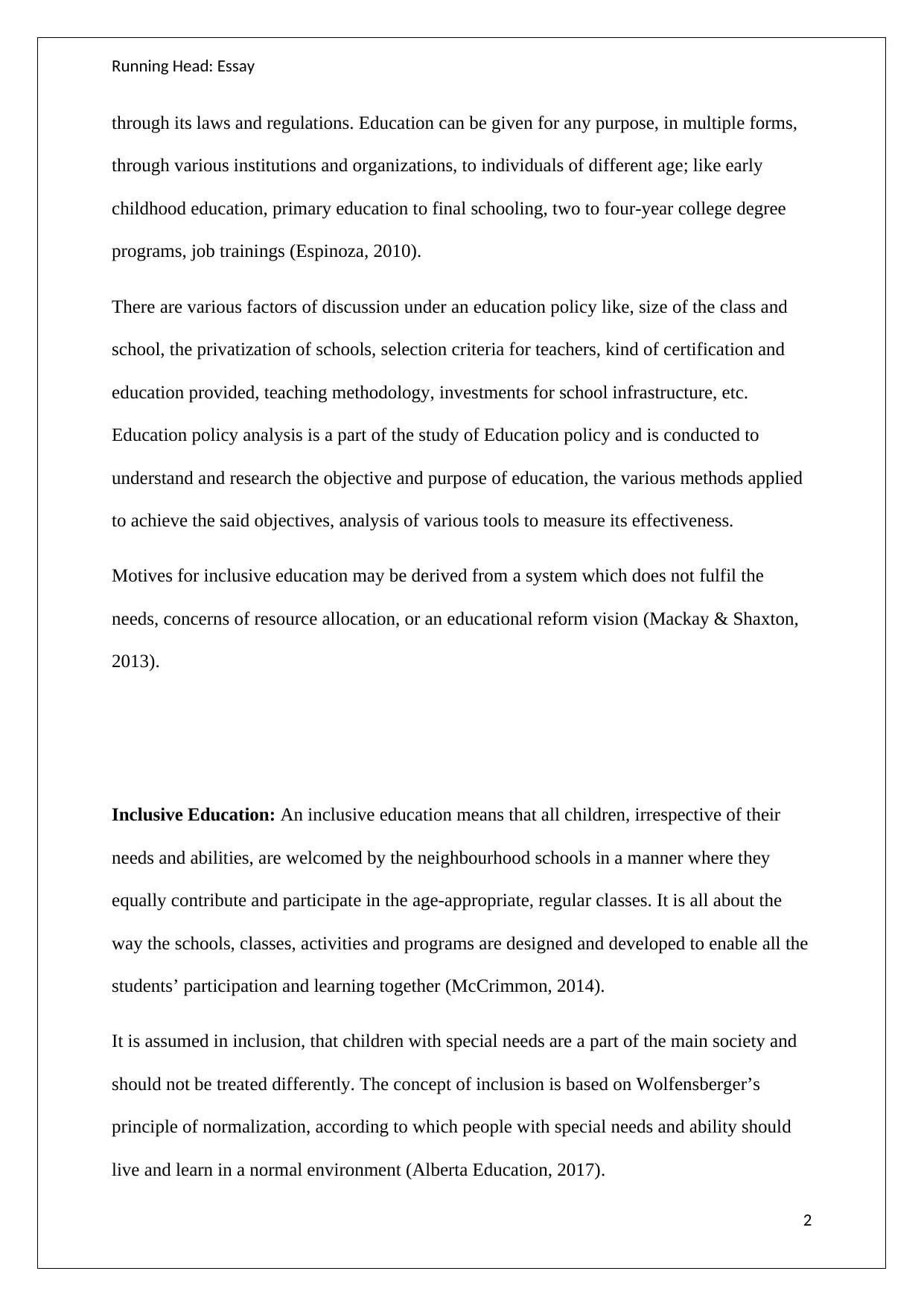
Running Head: Essay
through its laws and regulations. Education can be given for any purpose, in multiple forms,
through various institutions and organizations, to individuals of different age; like early
childhood education, primary education to final schooling, two to four-year college degree
programs, job trainings (Espinoza, 2010).
There are various factors of discussion under an education policy like, size of the class and
school, the privatization of schools, selection criteria for teachers, kind of certification and
education provided, teaching methodology, investments for school infrastructure, etc.
Education policy analysis is a part of the study of Education policy and is conducted to
understand and research the objective and purpose of education, the various methods applied
to achieve the said objectives, analysis of various tools to measure its effectiveness.
Motives for inclusive education may be derived from a system which does not fulfil the
needs, concerns of resource allocation, or an educational reform vision (Mackay & Shaxton,
2013).
Inclusive Education: An inclusive education means that all children, irrespective of their
needs and abilities, are welcomed by the neighbourhood schools in a manner where they
equally contribute and participate in the age-appropriate, regular classes. It is all about the
way the schools, classes, activities and programs are designed and developed to enable all the
students’ participation and learning together (McCrimmon, 2014).
It is assumed in inclusion, that children with special needs are a part of the main society and
should not be treated differently. The concept of inclusion is based on Wolfensberger’s
principle of normalization, according to which people with special needs and ability should
live and learn in a normal environment (Alberta Education, 2017).
2
through its laws and regulations. Education can be given for any purpose, in multiple forms,
through various institutions and organizations, to individuals of different age; like early
childhood education, primary education to final schooling, two to four-year college degree
programs, job trainings (Espinoza, 2010).
There are various factors of discussion under an education policy like, size of the class and
school, the privatization of schools, selection criteria for teachers, kind of certification and
education provided, teaching methodology, investments for school infrastructure, etc.
Education policy analysis is a part of the study of Education policy and is conducted to
understand and research the objective and purpose of education, the various methods applied
to achieve the said objectives, analysis of various tools to measure its effectiveness.
Motives for inclusive education may be derived from a system which does not fulfil the
needs, concerns of resource allocation, or an educational reform vision (Mackay & Shaxton,
2013).
Inclusive Education: An inclusive education means that all children, irrespective of their
needs and abilities, are welcomed by the neighbourhood schools in a manner where they
equally contribute and participate in the age-appropriate, regular classes. It is all about the
way the schools, classes, activities and programs are designed and developed to enable all the
students’ participation and learning together (McCrimmon, 2014).
It is assumed in inclusion, that children with special needs are a part of the main society and
should not be treated differently. The concept of inclusion is based on Wolfensberger’s
principle of normalization, according to which people with special needs and ability should
live and learn in a normal environment (Alberta Education, 2017).
2
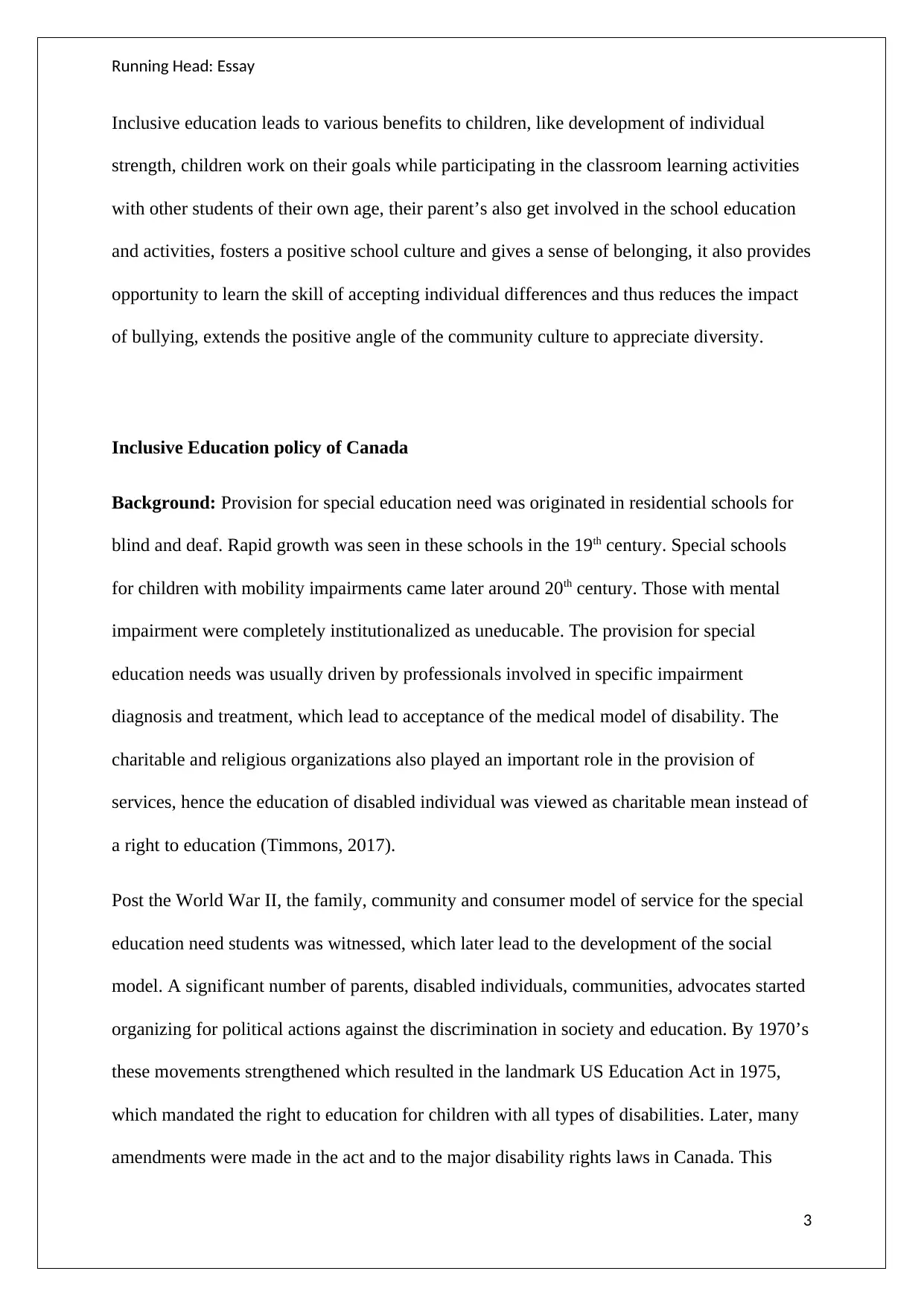
Running Head: Essay
Inclusive education leads to various benefits to children, like development of individual
strength, children work on their goals while participating in the classroom learning activities
with other students of their own age, their parent’s also get involved in the school education
and activities, fosters a positive school culture and gives a sense of belonging, it also provides
opportunity to learn the skill of accepting individual differences and thus reduces the impact
of bullying, extends the positive angle of the community culture to appreciate diversity.
Inclusive Education policy of Canada
Background: Provision for special education need was originated in residential schools for
blind and deaf. Rapid growth was seen in these schools in the 19th century. Special schools
for children with mobility impairments came later around 20th century. Those with mental
impairment were completely institutionalized as uneducable. The provision for special
education needs was usually driven by professionals involved in specific impairment
diagnosis and treatment, which lead to acceptance of the medical model of disability. The
charitable and religious organizations also played an important role in the provision of
services, hence the education of disabled individual was viewed as charitable mean instead of
a right to education (Timmons, 2017).
Post the World War II, the family, community and consumer model of service for the special
education need students was witnessed, which later lead to the development of the social
model. A significant number of parents, disabled individuals, communities, advocates started
organizing for political actions against the discrimination in society and education. By 1970’s
these movements strengthened which resulted in the landmark US Education Act in 1975,
which mandated the right to education for children with all types of disabilities. Later, many
amendments were made in the act and to the major disability rights laws in Canada. This
3
Inclusive education leads to various benefits to children, like development of individual
strength, children work on their goals while participating in the classroom learning activities
with other students of their own age, their parent’s also get involved in the school education
and activities, fosters a positive school culture and gives a sense of belonging, it also provides
opportunity to learn the skill of accepting individual differences and thus reduces the impact
of bullying, extends the positive angle of the community culture to appreciate diversity.
Inclusive Education policy of Canada
Background: Provision for special education need was originated in residential schools for
blind and deaf. Rapid growth was seen in these schools in the 19th century. Special schools
for children with mobility impairments came later around 20th century. Those with mental
impairment were completely institutionalized as uneducable. The provision for special
education needs was usually driven by professionals involved in specific impairment
diagnosis and treatment, which lead to acceptance of the medical model of disability. The
charitable and religious organizations also played an important role in the provision of
services, hence the education of disabled individual was viewed as charitable mean instead of
a right to education (Timmons, 2017).
Post the World War II, the family, community and consumer model of service for the special
education need students was witnessed, which later lead to the development of the social
model. A significant number of parents, disabled individuals, communities, advocates started
organizing for political actions against the discrimination in society and education. By 1970’s
these movements strengthened which resulted in the landmark US Education Act in 1975,
which mandated the right to education for children with all types of disabilities. Later, many
amendments were made in the act and to the major disability rights laws in Canada. This
3
Secure Best Marks with AI Grader
Need help grading? Try our AI Grader for instant feedback on your assignments.
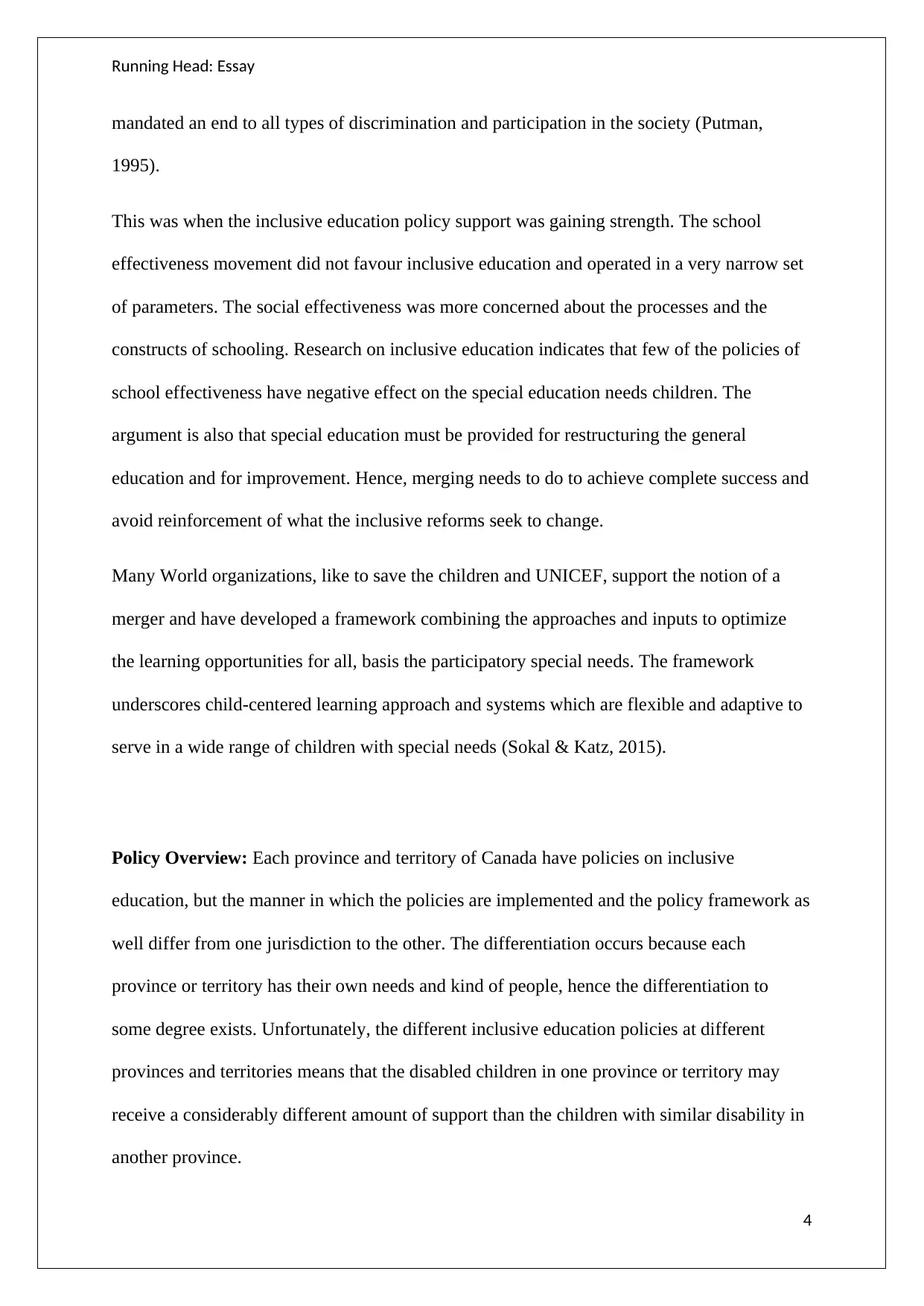
Running Head: Essay
mandated an end to all types of discrimination and participation in the society (Putman,
1995).
This was when the inclusive education policy support was gaining strength. The school
effectiveness movement did not favour inclusive education and operated in a very narrow set
of parameters. The social effectiveness was more concerned about the processes and the
constructs of schooling. Research on inclusive education indicates that few of the policies of
school effectiveness have negative effect on the special education needs children. The
argument is also that special education must be provided for restructuring the general
education and for improvement. Hence, merging needs to do to achieve complete success and
avoid reinforcement of what the inclusive reforms seek to change.
Many World organizations, like to save the children and UNICEF, support the notion of a
merger and have developed a framework combining the approaches and inputs to optimize
the learning opportunities for all, basis the participatory special needs. The framework
underscores child-centered learning approach and systems which are flexible and adaptive to
serve in a wide range of children with special needs (Sokal & Katz, 2015).
Policy Overview: Each province and territory of Canada have policies on inclusive
education, but the manner in which the policies are implemented and the policy framework as
well differ from one jurisdiction to the other. The differentiation occurs because each
province or territory has their own needs and kind of people, hence the differentiation to
some degree exists. Unfortunately, the different inclusive education policies at different
provinces and territories means that the disabled children in one province or territory may
receive a considerably different amount of support than the children with similar disability in
another province.
4
mandated an end to all types of discrimination and participation in the society (Putman,
1995).
This was when the inclusive education policy support was gaining strength. The school
effectiveness movement did not favour inclusive education and operated in a very narrow set
of parameters. The social effectiveness was more concerned about the processes and the
constructs of schooling. Research on inclusive education indicates that few of the policies of
school effectiveness have negative effect on the special education needs children. The
argument is also that special education must be provided for restructuring the general
education and for improvement. Hence, merging needs to do to achieve complete success and
avoid reinforcement of what the inclusive reforms seek to change.
Many World organizations, like to save the children and UNICEF, support the notion of a
merger and have developed a framework combining the approaches and inputs to optimize
the learning opportunities for all, basis the participatory special needs. The framework
underscores child-centered learning approach and systems which are flexible and adaptive to
serve in a wide range of children with special needs (Sokal & Katz, 2015).
Policy Overview: Each province and territory of Canada have policies on inclusive
education, but the manner in which the policies are implemented and the policy framework as
well differ from one jurisdiction to the other. The differentiation occurs because each
province or territory has their own needs and kind of people, hence the differentiation to
some degree exists. Unfortunately, the different inclusive education policies at different
provinces and territories means that the disabled children in one province or territory may
receive a considerably different amount of support than the children with similar disability in
another province.
4
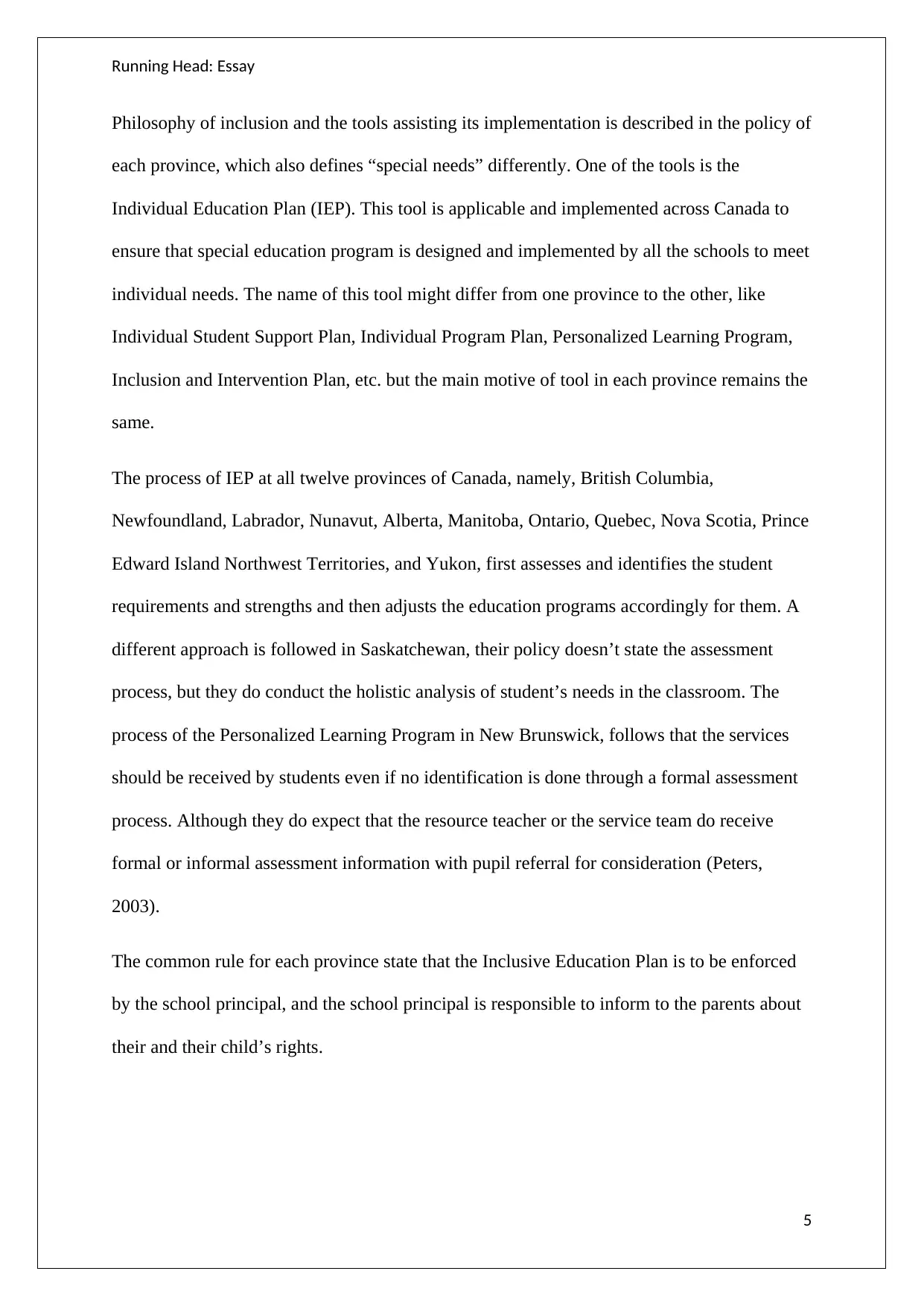
Running Head: Essay
Philosophy of inclusion and the tools assisting its implementation is described in the policy of
each province, which also defines “special needs” differently. One of the tools is the
Individual Education Plan (IEP). This tool is applicable and implemented across Canada to
ensure that special education program is designed and implemented by all the schools to meet
individual needs. The name of this tool might differ from one province to the other, like
Individual Student Support Plan, Individual Program Plan, Personalized Learning Program,
Inclusion and Intervention Plan, etc. but the main motive of tool in each province remains the
same.
The process of IEP at all twelve provinces of Canada, namely, British Columbia,
Newfoundland, Labrador, Nunavut, Alberta, Manitoba, Ontario, Quebec, Nova Scotia, Prince
Edward Island Northwest Territories, and Yukon, first assesses and identifies the student
requirements and strengths and then adjusts the education programs accordingly for them. A
different approach is followed in Saskatchewan, their policy doesn’t state the assessment
process, but they do conduct the holistic analysis of student’s needs in the classroom. The
process of the Personalized Learning Program in New Brunswick, follows that the services
should be received by students even if no identification is done through a formal assessment
process. Although they do expect that the resource teacher or the service team do receive
formal or informal assessment information with pupil referral for consideration (Peters,
2003).
The common rule for each province state that the Inclusive Education Plan is to be enforced
by the school principal, and the school principal is responsible to inform to the parents about
their and their child’s rights.
5
Philosophy of inclusion and the tools assisting its implementation is described in the policy of
each province, which also defines “special needs” differently. One of the tools is the
Individual Education Plan (IEP). This tool is applicable and implemented across Canada to
ensure that special education program is designed and implemented by all the schools to meet
individual needs. The name of this tool might differ from one province to the other, like
Individual Student Support Plan, Individual Program Plan, Personalized Learning Program,
Inclusion and Intervention Plan, etc. but the main motive of tool in each province remains the
same.
The process of IEP at all twelve provinces of Canada, namely, British Columbia,
Newfoundland, Labrador, Nunavut, Alberta, Manitoba, Ontario, Quebec, Nova Scotia, Prince
Edward Island Northwest Territories, and Yukon, first assesses and identifies the student
requirements and strengths and then adjusts the education programs accordingly for them. A
different approach is followed in Saskatchewan, their policy doesn’t state the assessment
process, but they do conduct the holistic analysis of student’s needs in the classroom. The
process of the Personalized Learning Program in New Brunswick, follows that the services
should be received by students even if no identification is done through a formal assessment
process. Although they do expect that the resource teacher or the service team do receive
formal or informal assessment information with pupil referral for consideration (Peters,
2003).
The common rule for each province state that the Inclusive Education Plan is to be enforced
by the school principal, and the school principal is responsible to inform to the parents about
their and their child’s rights.
5
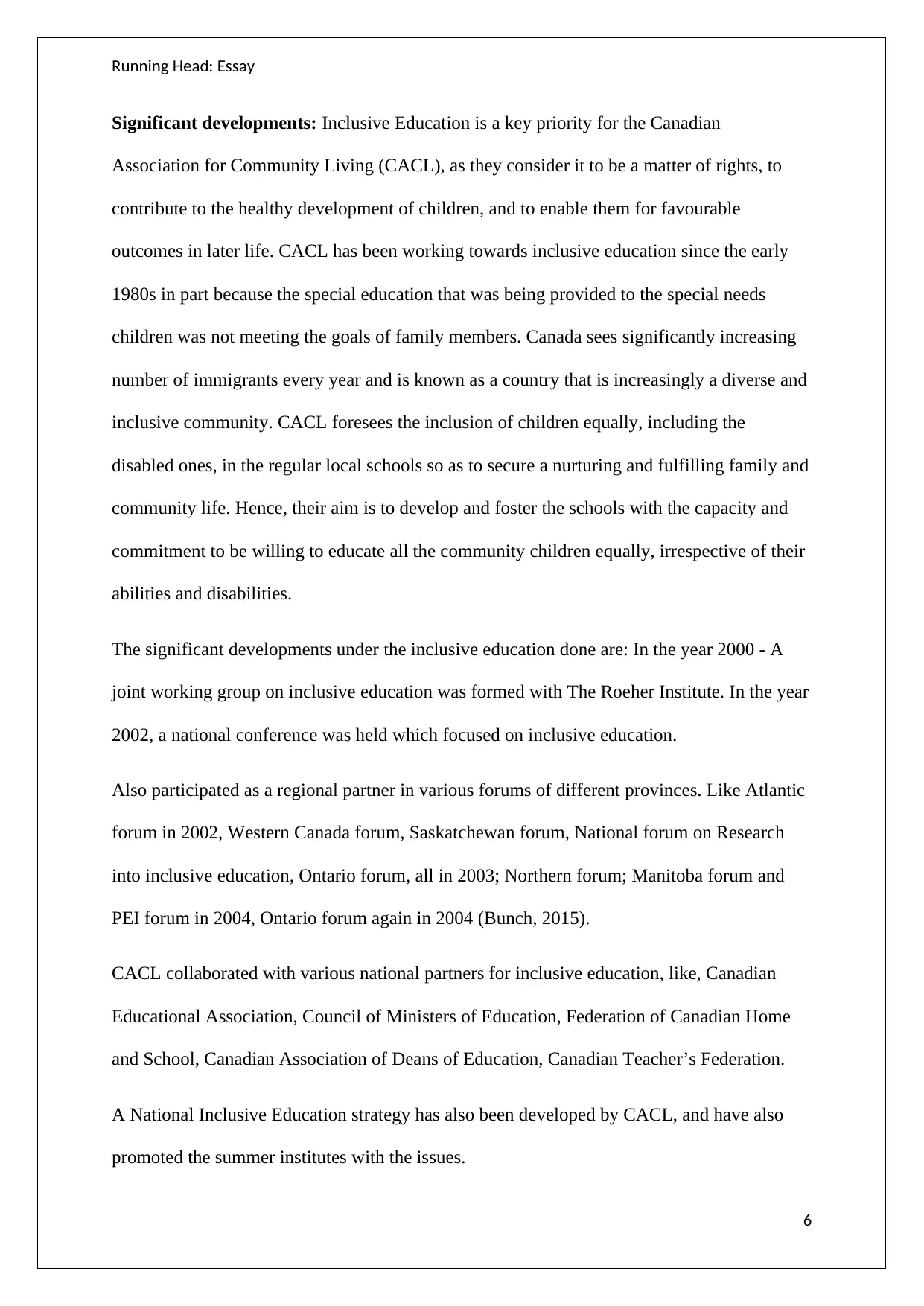
Running Head: Essay
Significant developments: Inclusive Education is a key priority for the Canadian
Association for Community Living (CACL), as they consider it to be a matter of rights, to
contribute to the healthy development of children, and to enable them for favourable
outcomes in later life. CACL has been working towards inclusive education since the early
1980s in part because the special education that was being provided to the special needs
children was not meeting the goals of family members. Canada sees significantly increasing
number of immigrants every year and is known as a country that is increasingly a diverse and
inclusive community. CACL foresees the inclusion of children equally, including the
disabled ones, in the regular local schools so as to secure a nurturing and fulfilling family and
community life. Hence, their aim is to develop and foster the schools with the capacity and
commitment to be willing to educate all the community children equally, irrespective of their
abilities and disabilities.
The significant developments under the inclusive education done are: In the year 2000 - A
joint working group on inclusive education was formed with The Roeher Institute. In the year
2002, a national conference was held which focused on inclusive education.
Also participated as a regional partner in various forums of different provinces. Like Atlantic
forum in 2002, Western Canada forum, Saskatchewan forum, National forum on Research
into inclusive education, Ontario forum, all in 2003; Northern forum; Manitoba forum and
PEI forum in 2004, Ontario forum again in 2004 (Bunch, 2015).
CACL collaborated with various national partners for inclusive education, like, Canadian
Educational Association, Council of Ministers of Education, Federation of Canadian Home
and School, Canadian Association of Deans of Education, Canadian Teacher’s Federation.
A National Inclusive Education strategy has also been developed by CACL, and have also
promoted the summer institutes with the issues.
6
Significant developments: Inclusive Education is a key priority for the Canadian
Association for Community Living (CACL), as they consider it to be a matter of rights, to
contribute to the healthy development of children, and to enable them for favourable
outcomes in later life. CACL has been working towards inclusive education since the early
1980s in part because the special education that was being provided to the special needs
children was not meeting the goals of family members. Canada sees significantly increasing
number of immigrants every year and is known as a country that is increasingly a diverse and
inclusive community. CACL foresees the inclusion of children equally, including the
disabled ones, in the regular local schools so as to secure a nurturing and fulfilling family and
community life. Hence, their aim is to develop and foster the schools with the capacity and
commitment to be willing to educate all the community children equally, irrespective of their
abilities and disabilities.
The significant developments under the inclusive education done are: In the year 2000 - A
joint working group on inclusive education was formed with The Roeher Institute. In the year
2002, a national conference was held which focused on inclusive education.
Also participated as a regional partner in various forums of different provinces. Like Atlantic
forum in 2002, Western Canada forum, Saskatchewan forum, National forum on Research
into inclusive education, Ontario forum, all in 2003; Northern forum; Manitoba forum and
PEI forum in 2004, Ontario forum again in 2004 (Bunch, 2015).
CACL collaborated with various national partners for inclusive education, like, Canadian
Educational Association, Council of Ministers of Education, Federation of Canadian Home
and School, Canadian Association of Deans of Education, Canadian Teacher’s Federation.
A National Inclusive Education strategy has also been developed by CACL, and have also
promoted the summer institutes with the issues.
6
Paraphrase This Document
Need a fresh take? Get an instant paraphrase of this document with our AI Paraphraser
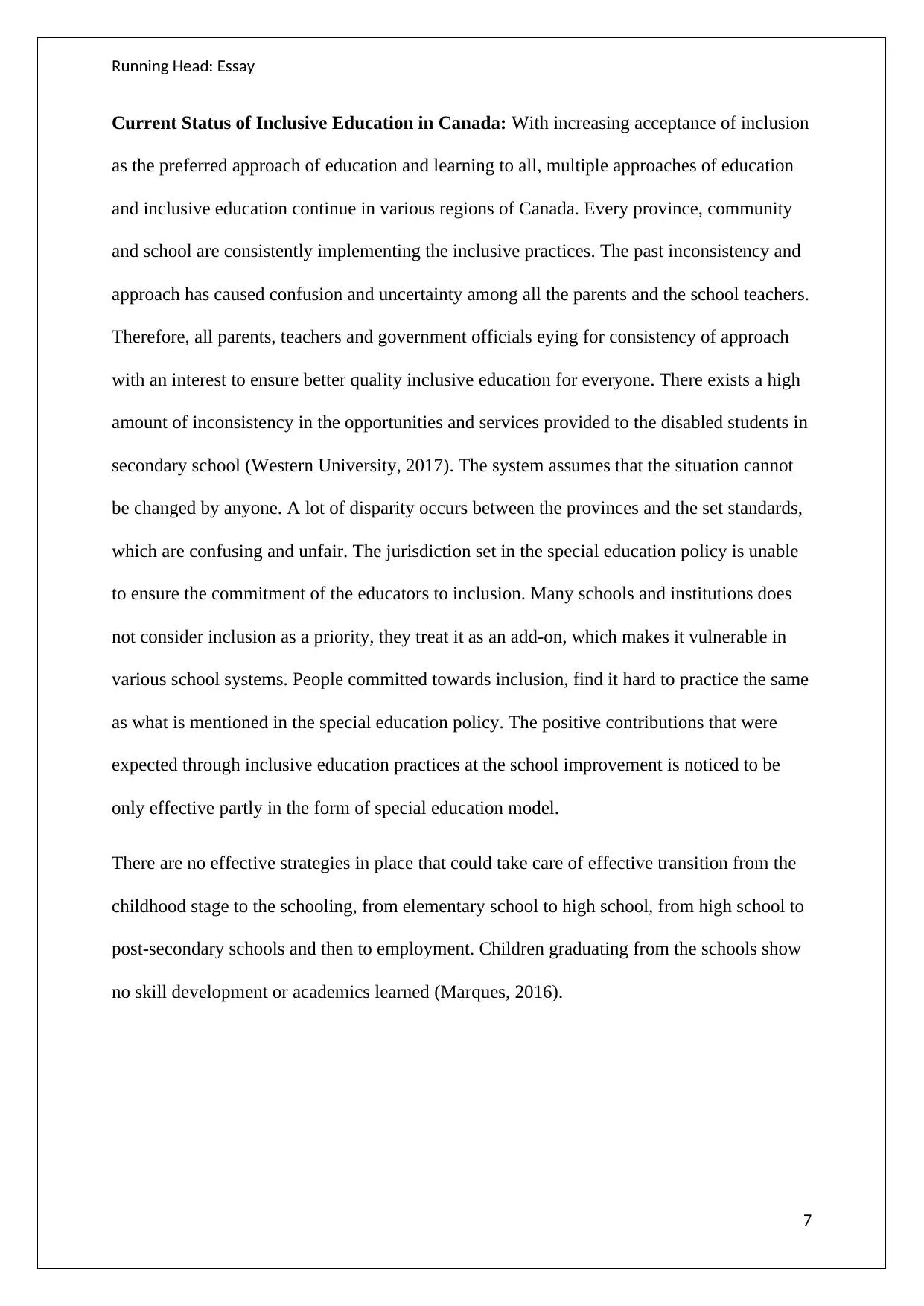
Running Head: Essay
Current Status of Inclusive Education in Canada: With increasing acceptance of inclusion
as the preferred approach of education and learning to all, multiple approaches of education
and inclusive education continue in various regions of Canada. Every province, community
and school are consistently implementing the inclusive practices. The past inconsistency and
approach has caused confusion and uncertainty among all the parents and the school teachers.
Therefore, all parents, teachers and government officials eying for consistency of approach
with an interest to ensure better quality inclusive education for everyone. There exists a high
amount of inconsistency in the opportunities and services provided to the disabled students in
secondary school (Western University, 2017). The system assumes that the situation cannot
be changed by anyone. A lot of disparity occurs between the provinces and the set standards,
which are confusing and unfair. The jurisdiction set in the special education policy is unable
to ensure the commitment of the educators to inclusion. Many schools and institutions does
not consider inclusion as a priority, they treat it as an add-on, which makes it vulnerable in
various school systems. People committed towards inclusion, find it hard to practice the same
as what is mentioned in the special education policy. The positive contributions that were
expected through inclusive education practices at the school improvement is noticed to be
only effective partly in the form of special education model.
There are no effective strategies in place that could take care of effective transition from the
childhood stage to the schooling, from elementary school to high school, from high school to
post-secondary schools and then to employment. Children graduating from the schools show
no skill development or academics learned (Marques, 2016).
7
Current Status of Inclusive Education in Canada: With increasing acceptance of inclusion
as the preferred approach of education and learning to all, multiple approaches of education
and inclusive education continue in various regions of Canada. Every province, community
and school are consistently implementing the inclusive practices. The past inconsistency and
approach has caused confusion and uncertainty among all the parents and the school teachers.
Therefore, all parents, teachers and government officials eying for consistency of approach
with an interest to ensure better quality inclusive education for everyone. There exists a high
amount of inconsistency in the opportunities and services provided to the disabled students in
secondary school (Western University, 2017). The system assumes that the situation cannot
be changed by anyone. A lot of disparity occurs between the provinces and the set standards,
which are confusing and unfair. The jurisdiction set in the special education policy is unable
to ensure the commitment of the educators to inclusion. Many schools and institutions does
not consider inclusion as a priority, they treat it as an add-on, which makes it vulnerable in
various school systems. People committed towards inclusion, find it hard to practice the same
as what is mentioned in the special education policy. The positive contributions that were
expected through inclusive education practices at the school improvement is noticed to be
only effective partly in the form of special education model.
There are no effective strategies in place that could take care of effective transition from the
childhood stage to the schooling, from elementary school to high school, from high school to
post-secondary schools and then to employment. Children graduating from the schools show
no skill development or academics learned (Marques, 2016).
7
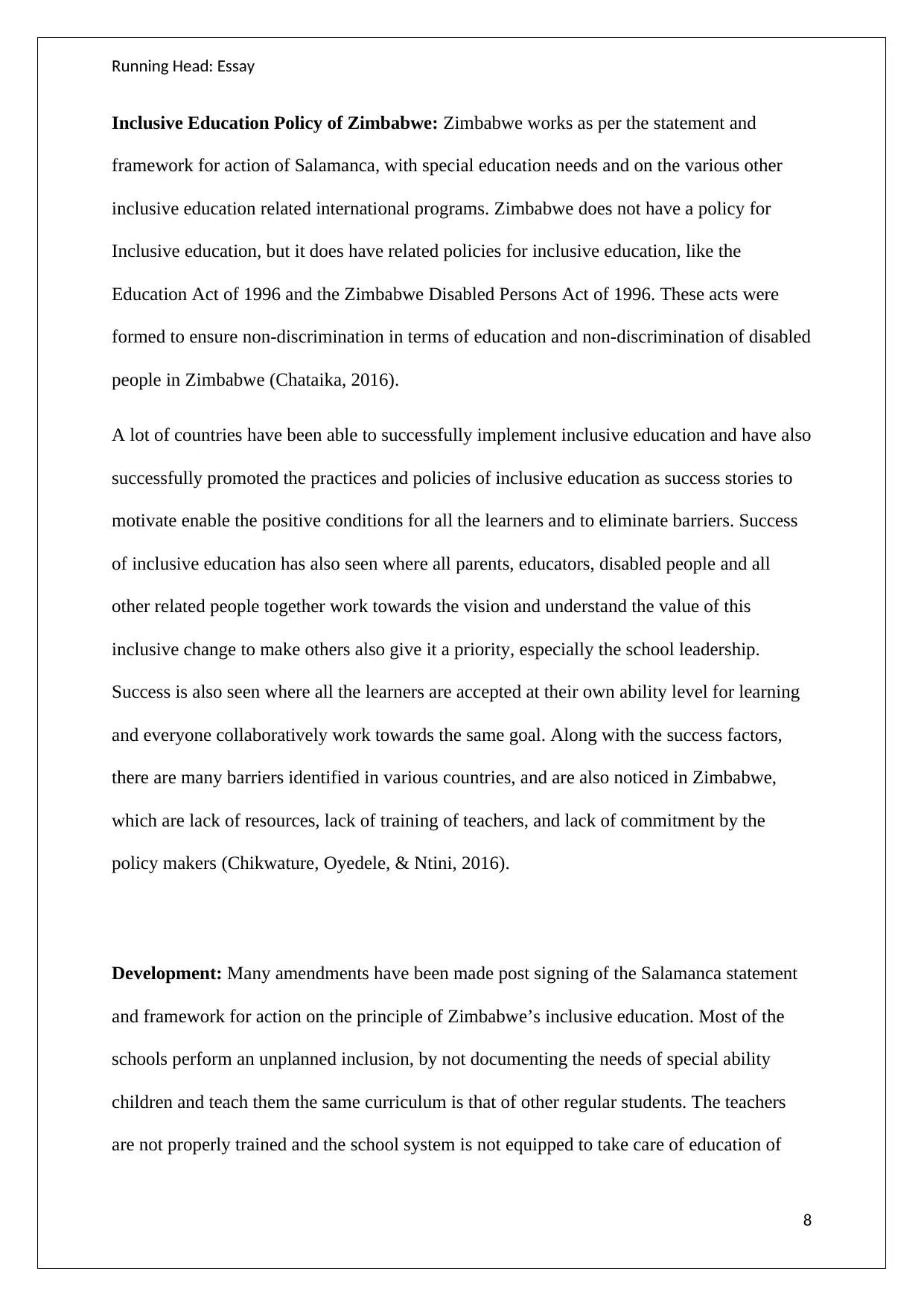
Running Head: Essay
Inclusive Education Policy of Zimbabwe: Zimbabwe works as per the statement and
framework for action of Salamanca, with special education needs and on the various other
inclusive education related international programs. Zimbabwe does not have a policy for
Inclusive education, but it does have related policies for inclusive education, like the
Education Act of 1996 and the Zimbabwe Disabled Persons Act of 1996. These acts were
formed to ensure non-discrimination in terms of education and non-discrimination of disabled
people in Zimbabwe (Chataika, 2016).
A lot of countries have been able to successfully implement inclusive education and have also
successfully promoted the practices and policies of inclusive education as success stories to
motivate enable the positive conditions for all the learners and to eliminate barriers. Success
of inclusive education has also seen where all parents, educators, disabled people and all
other related people together work towards the vision and understand the value of this
inclusive change to make others also give it a priority, especially the school leadership.
Success is also seen where all the learners are accepted at their own ability level for learning
and everyone collaboratively work towards the same goal. Along with the success factors,
there are many barriers identified in various countries, and are also noticed in Zimbabwe,
which are lack of resources, lack of training of teachers, and lack of commitment by the
policy makers (Chikwature, Oyedele, & Ntini, 2016).
Development: Many amendments have been made post signing of the Salamanca statement
and framework for action on the principle of Zimbabwe’s inclusive education. Most of the
schools perform an unplanned inclusion, by not documenting the needs of special ability
children and teach them the same curriculum is that of other regular students. The teachers
are not properly trained and the school system is not equipped to take care of education of
8
Inclusive Education Policy of Zimbabwe: Zimbabwe works as per the statement and
framework for action of Salamanca, with special education needs and on the various other
inclusive education related international programs. Zimbabwe does not have a policy for
Inclusive education, but it does have related policies for inclusive education, like the
Education Act of 1996 and the Zimbabwe Disabled Persons Act of 1996. These acts were
formed to ensure non-discrimination in terms of education and non-discrimination of disabled
people in Zimbabwe (Chataika, 2016).
A lot of countries have been able to successfully implement inclusive education and have also
successfully promoted the practices and policies of inclusive education as success stories to
motivate enable the positive conditions for all the learners and to eliminate barriers. Success
of inclusive education has also seen where all parents, educators, disabled people and all
other related people together work towards the vision and understand the value of this
inclusive change to make others also give it a priority, especially the school leadership.
Success is also seen where all the learners are accepted at their own ability level for learning
and everyone collaboratively work towards the same goal. Along with the success factors,
there are many barriers identified in various countries, and are also noticed in Zimbabwe,
which are lack of resources, lack of training of teachers, and lack of commitment by the
policy makers (Chikwature, Oyedele, & Ntini, 2016).
Development: Many amendments have been made post signing of the Salamanca statement
and framework for action on the principle of Zimbabwe’s inclusive education. Most of the
schools perform an unplanned inclusion, by not documenting the needs of special ability
children and teach them the same curriculum is that of other regular students. The teachers
are not properly trained and the school system is not equipped to take care of education of
8
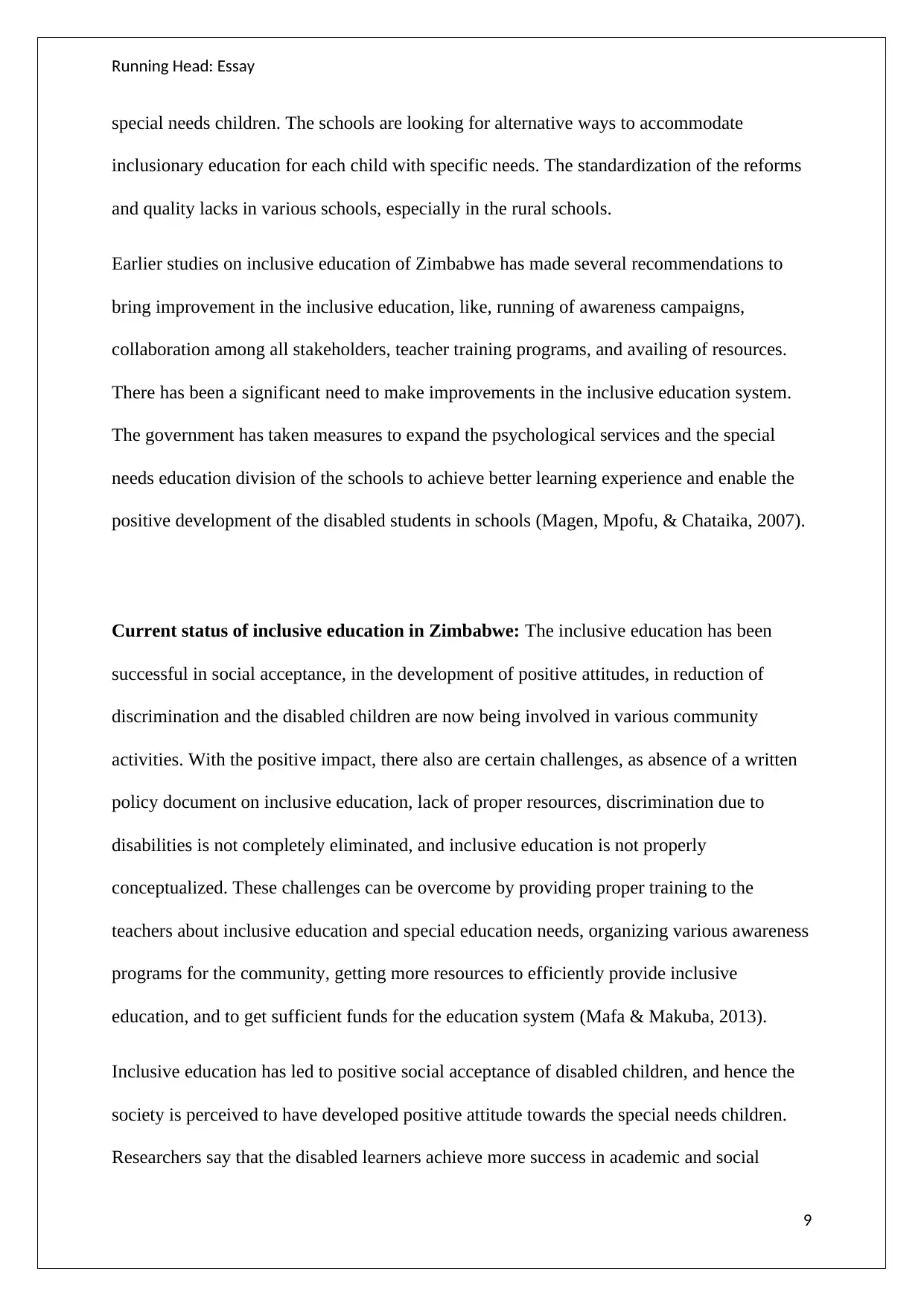
Running Head: Essay
special needs children. The schools are looking for alternative ways to accommodate
inclusionary education for each child with specific needs. The standardization of the reforms
and quality lacks in various schools, especially in the rural schools.
Earlier studies on inclusive education of Zimbabwe has made several recommendations to
bring improvement in the inclusive education, like, running of awareness campaigns,
collaboration among all stakeholders, teacher training programs, and availing of resources.
There has been a significant need to make improvements in the inclusive education system.
The government has taken measures to expand the psychological services and the special
needs education division of the schools to achieve better learning experience and enable the
positive development of the disabled students in schools (Magen, Mpofu, & Chataika, 2007).
Current status of inclusive education in Zimbabwe: The inclusive education has been
successful in social acceptance, in the development of positive attitudes, in reduction of
discrimination and the disabled children are now being involved in various community
activities. With the positive impact, there also are certain challenges, as absence of a written
policy document on inclusive education, lack of proper resources, discrimination due to
disabilities is not completely eliminated, and inclusive education is not properly
conceptualized. These challenges can be overcome by providing proper training to the
teachers about inclusive education and special education needs, organizing various awareness
programs for the community, getting more resources to efficiently provide inclusive
education, and to get sufficient funds for the education system (Mafa & Makuba, 2013).
Inclusive education has led to positive social acceptance of disabled children, and hence the
society is perceived to have developed positive attitude towards the special needs children.
Researchers say that the disabled learners achieve more success in academic and social
9
special needs children. The schools are looking for alternative ways to accommodate
inclusionary education for each child with specific needs. The standardization of the reforms
and quality lacks in various schools, especially in the rural schools.
Earlier studies on inclusive education of Zimbabwe has made several recommendations to
bring improvement in the inclusive education, like, running of awareness campaigns,
collaboration among all stakeholders, teacher training programs, and availing of resources.
There has been a significant need to make improvements in the inclusive education system.
The government has taken measures to expand the psychological services and the special
needs education division of the schools to achieve better learning experience and enable the
positive development of the disabled students in schools (Magen, Mpofu, & Chataika, 2007).
Current status of inclusive education in Zimbabwe: The inclusive education has been
successful in social acceptance, in the development of positive attitudes, in reduction of
discrimination and the disabled children are now being involved in various community
activities. With the positive impact, there also are certain challenges, as absence of a written
policy document on inclusive education, lack of proper resources, discrimination due to
disabilities is not completely eliminated, and inclusive education is not properly
conceptualized. These challenges can be overcome by providing proper training to the
teachers about inclusive education and special education needs, organizing various awareness
programs for the community, getting more resources to efficiently provide inclusive
education, and to get sufficient funds for the education system (Mafa & Makuba, 2013).
Inclusive education has led to positive social acceptance of disabled children, and hence the
society is perceived to have developed positive attitude towards the special needs children.
Researchers say that the disabled learners achieve more success in academic and social
9
Secure Best Marks with AI Grader
Need help grading? Try our AI Grader for instant feedback on your assignments.
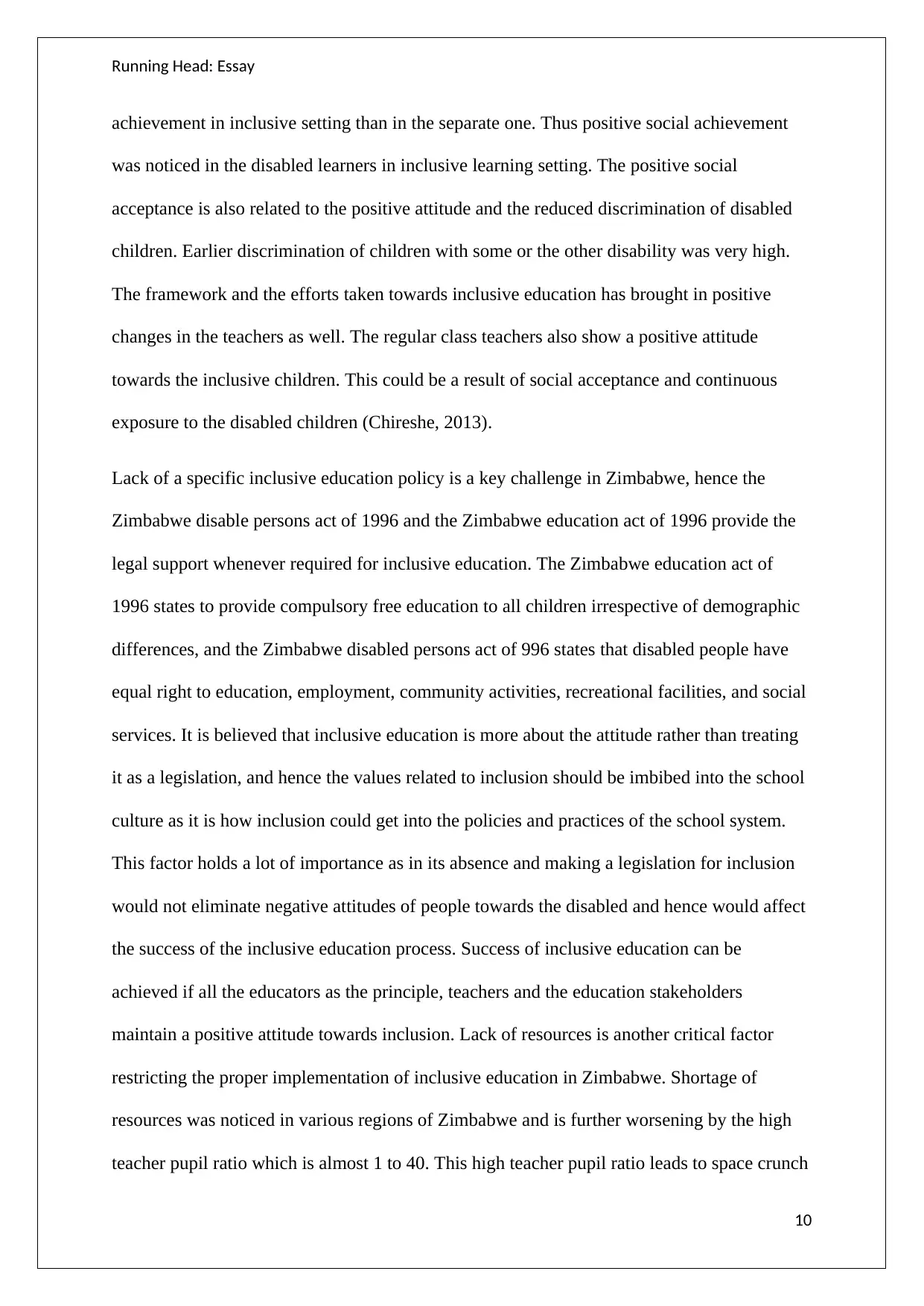
Running Head: Essay
achievement in inclusive setting than in the separate one. Thus positive social achievement
was noticed in the disabled learners in inclusive learning setting. The positive social
acceptance is also related to the positive attitude and the reduced discrimination of disabled
children. Earlier discrimination of children with some or the other disability was very high.
The framework and the efforts taken towards inclusive education has brought in positive
changes in the teachers as well. The regular class teachers also show a positive attitude
towards the inclusive children. This could be a result of social acceptance and continuous
exposure to the disabled children (Chireshe, 2013).
Lack of a specific inclusive education policy is a key challenge in Zimbabwe, hence the
Zimbabwe disable persons act of 1996 and the Zimbabwe education act of 1996 provide the
legal support whenever required for inclusive education. The Zimbabwe education act of
1996 states to provide compulsory free education to all children irrespective of demographic
differences, and the Zimbabwe disabled persons act of 996 states that disabled people have
equal right to education, employment, community activities, recreational facilities, and social
services. It is believed that inclusive education is more about the attitude rather than treating
it as a legislation, and hence the values related to inclusion should be imbibed into the school
culture as it is how inclusion could get into the policies and practices of the school system.
This factor holds a lot of importance as in its absence and making a legislation for inclusion
would not eliminate negative attitudes of people towards the disabled and hence would affect
the success of the inclusive education process. Success of inclusive education can be
achieved if all the educators as the principle, teachers and the education stakeholders
maintain a positive attitude towards inclusion. Lack of resources is another critical factor
restricting the proper implementation of inclusive education in Zimbabwe. Shortage of
resources was noticed in various regions of Zimbabwe and is further worsening by the high
teacher pupil ratio which is almost 1 to 40. This high teacher pupil ratio leads to space crunch
10
achievement in inclusive setting than in the separate one. Thus positive social achievement
was noticed in the disabled learners in inclusive learning setting. The positive social
acceptance is also related to the positive attitude and the reduced discrimination of disabled
children. Earlier discrimination of children with some or the other disability was very high.
The framework and the efforts taken towards inclusive education has brought in positive
changes in the teachers as well. The regular class teachers also show a positive attitude
towards the inclusive children. This could be a result of social acceptance and continuous
exposure to the disabled children (Chireshe, 2013).
Lack of a specific inclusive education policy is a key challenge in Zimbabwe, hence the
Zimbabwe disable persons act of 1996 and the Zimbabwe education act of 1996 provide the
legal support whenever required for inclusive education. The Zimbabwe education act of
1996 states to provide compulsory free education to all children irrespective of demographic
differences, and the Zimbabwe disabled persons act of 996 states that disabled people have
equal right to education, employment, community activities, recreational facilities, and social
services. It is believed that inclusive education is more about the attitude rather than treating
it as a legislation, and hence the values related to inclusion should be imbibed into the school
culture as it is how inclusion could get into the policies and practices of the school system.
This factor holds a lot of importance as in its absence and making a legislation for inclusion
would not eliminate negative attitudes of people towards the disabled and hence would affect
the success of the inclusive education process. Success of inclusive education can be
achieved if all the educators as the principle, teachers and the education stakeholders
maintain a positive attitude towards inclusion. Lack of resources is another critical factor
restricting the proper implementation of inclusive education in Zimbabwe. Shortage of
resources was noticed in various regions of Zimbabwe and is further worsening by the high
teacher pupil ratio which is almost 1 to 40. This high teacher pupil ratio leads to space crunch
10
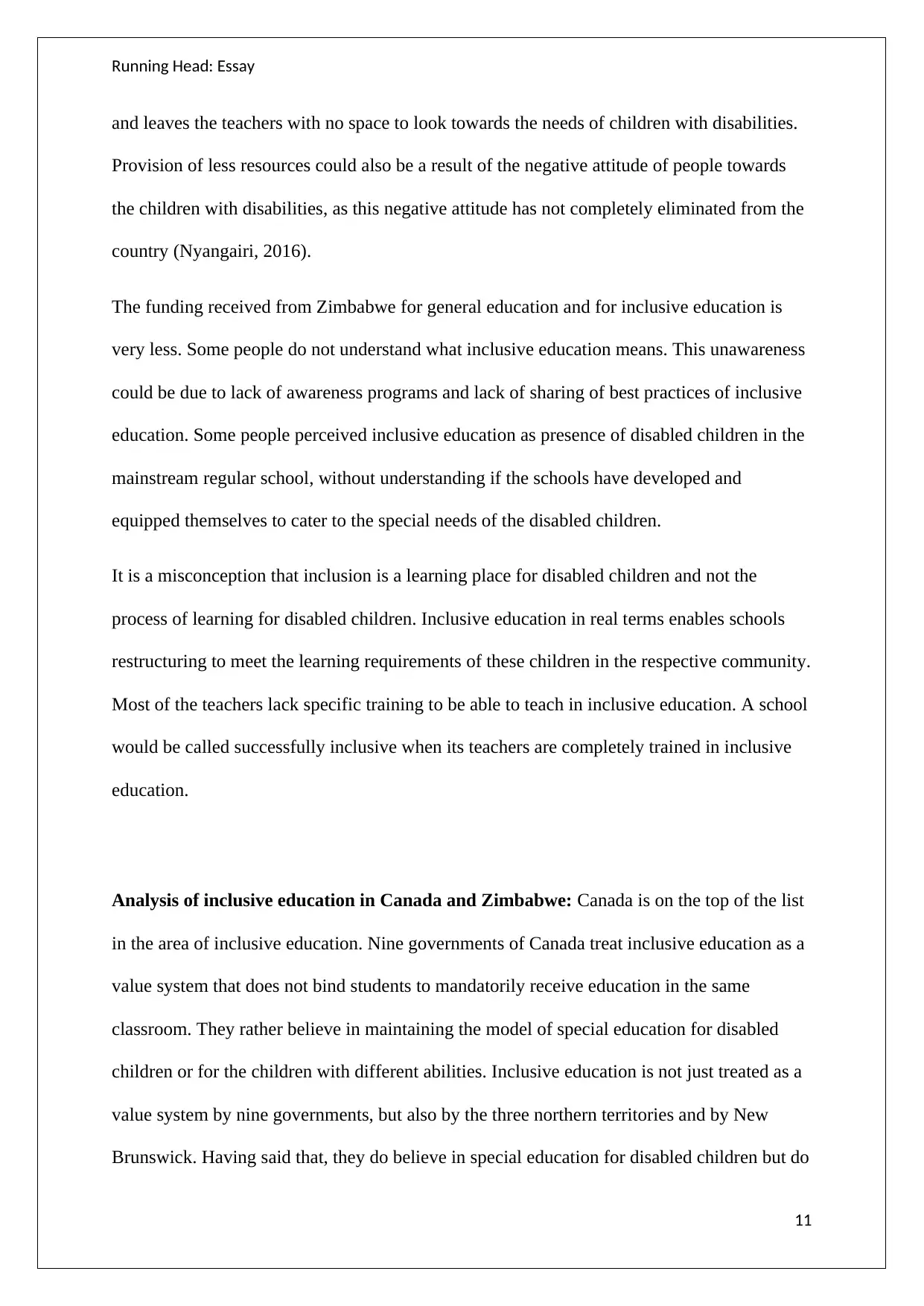
Running Head: Essay
and leaves the teachers with no space to look towards the needs of children with disabilities.
Provision of less resources could also be a result of the negative attitude of people towards
the children with disabilities, as this negative attitude has not completely eliminated from the
country (Nyangairi, 2016).
The funding received from Zimbabwe for general education and for inclusive education is
very less. Some people do not understand what inclusive education means. This unawareness
could be due to lack of awareness programs and lack of sharing of best practices of inclusive
education. Some people perceived inclusive education as presence of disabled children in the
mainstream regular school, without understanding if the schools have developed and
equipped themselves to cater to the special needs of the disabled children.
It is a misconception that inclusion is a learning place for disabled children and not the
process of learning for disabled children. Inclusive education in real terms enables schools
restructuring to meet the learning requirements of these children in the respective community.
Most of the teachers lack specific training to be able to teach in inclusive education. A school
would be called successfully inclusive when its teachers are completely trained in inclusive
education.
Analysis of inclusive education in Canada and Zimbabwe: Canada is on the top of the list
in the area of inclusive education. Nine governments of Canada treat inclusive education as a
value system that does not bind students to mandatorily receive education in the same
classroom. They rather believe in maintaining the model of special education for disabled
children or for the children with different abilities. Inclusive education is not just treated as a
value system by nine governments, but also by the three northern territories and by New
Brunswick. Having said that, they do believe in special education for disabled children but do
11
and leaves the teachers with no space to look towards the needs of children with disabilities.
Provision of less resources could also be a result of the negative attitude of people towards
the children with disabilities, as this negative attitude has not completely eliminated from the
country (Nyangairi, 2016).
The funding received from Zimbabwe for general education and for inclusive education is
very less. Some people do not understand what inclusive education means. This unawareness
could be due to lack of awareness programs and lack of sharing of best practices of inclusive
education. Some people perceived inclusive education as presence of disabled children in the
mainstream regular school, without understanding if the schools have developed and
equipped themselves to cater to the special needs of the disabled children.
It is a misconception that inclusion is a learning place for disabled children and not the
process of learning for disabled children. Inclusive education in real terms enables schools
restructuring to meet the learning requirements of these children in the respective community.
Most of the teachers lack specific training to be able to teach in inclusive education. A school
would be called successfully inclusive when its teachers are completely trained in inclusive
education.
Analysis of inclusive education in Canada and Zimbabwe: Canada is on the top of the list
in the area of inclusive education. Nine governments of Canada treat inclusive education as a
value system that does not bind students to mandatorily receive education in the same
classroom. They rather believe in maintaining the model of special education for disabled
children or for the children with different abilities. Inclusive education is not just treated as a
value system by nine governments, but also by the three northern territories and by New
Brunswick. Having said that, they do believe in special education for disabled children but do
11
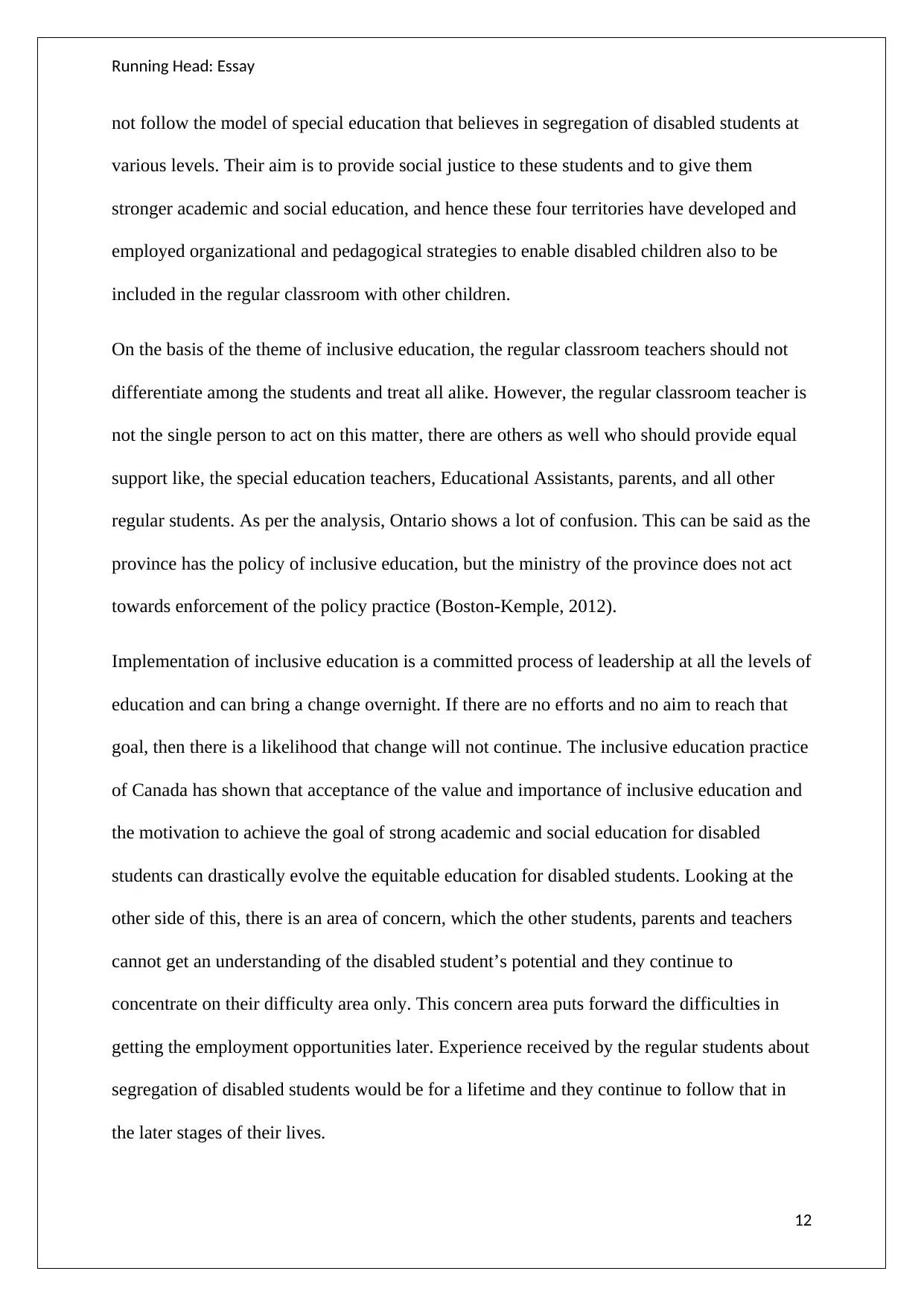
Running Head: Essay
not follow the model of special education that believes in segregation of disabled students at
various levels. Their aim is to provide social justice to these students and to give them
stronger academic and social education, and hence these four territories have developed and
employed organizational and pedagogical strategies to enable disabled children also to be
included in the regular classroom with other children.
On the basis of the theme of inclusive education, the regular classroom teachers should not
differentiate among the students and treat all alike. However, the regular classroom teacher is
not the single person to act on this matter, there are others as well who should provide equal
support like, the special education teachers, Educational Assistants, parents, and all other
regular students. As per the analysis, Ontario shows a lot of confusion. This can be said as the
province has the policy of inclusive education, but the ministry of the province does not act
towards enforcement of the policy practice (Boston-Kemple, 2012).
Implementation of inclusive education is a committed process of leadership at all the levels of
education and can bring a change overnight. If there are no efforts and no aim to reach that
goal, then there is a likelihood that change will not continue. The inclusive education practice
of Canada has shown that acceptance of the value and importance of inclusive education and
the motivation to achieve the goal of strong academic and social education for disabled
students can drastically evolve the equitable education for disabled students. Looking at the
other side of this, there is an area of concern, which the other students, parents and teachers
cannot get an understanding of the disabled student’s potential and they continue to
concentrate on their difficulty area only. This concern area puts forward the difficulties in
getting the employment opportunities later. Experience received by the regular students about
segregation of disabled students would be for a lifetime and they continue to follow that in
the later stages of their lives.
12
not follow the model of special education that believes in segregation of disabled students at
various levels. Their aim is to provide social justice to these students and to give them
stronger academic and social education, and hence these four territories have developed and
employed organizational and pedagogical strategies to enable disabled children also to be
included in the regular classroom with other children.
On the basis of the theme of inclusive education, the regular classroom teachers should not
differentiate among the students and treat all alike. However, the regular classroom teacher is
not the single person to act on this matter, there are others as well who should provide equal
support like, the special education teachers, Educational Assistants, parents, and all other
regular students. As per the analysis, Ontario shows a lot of confusion. This can be said as the
province has the policy of inclusive education, but the ministry of the province does not act
towards enforcement of the policy practice (Boston-Kemple, 2012).
Implementation of inclusive education is a committed process of leadership at all the levels of
education and can bring a change overnight. If there are no efforts and no aim to reach that
goal, then there is a likelihood that change will not continue. The inclusive education practice
of Canada has shown that acceptance of the value and importance of inclusive education and
the motivation to achieve the goal of strong academic and social education for disabled
students can drastically evolve the equitable education for disabled students. Looking at the
other side of this, there is an area of concern, which the other students, parents and teachers
cannot get an understanding of the disabled student’s potential and they continue to
concentrate on their difficulty area only. This concern area puts forward the difficulties in
getting the employment opportunities later. Experience received by the regular students about
segregation of disabled students would be for a lifetime and they continue to follow that in
the later stages of their lives.
12
Paraphrase This Document
Need a fresh take? Get an instant paraphrase of this document with our AI Paraphraser
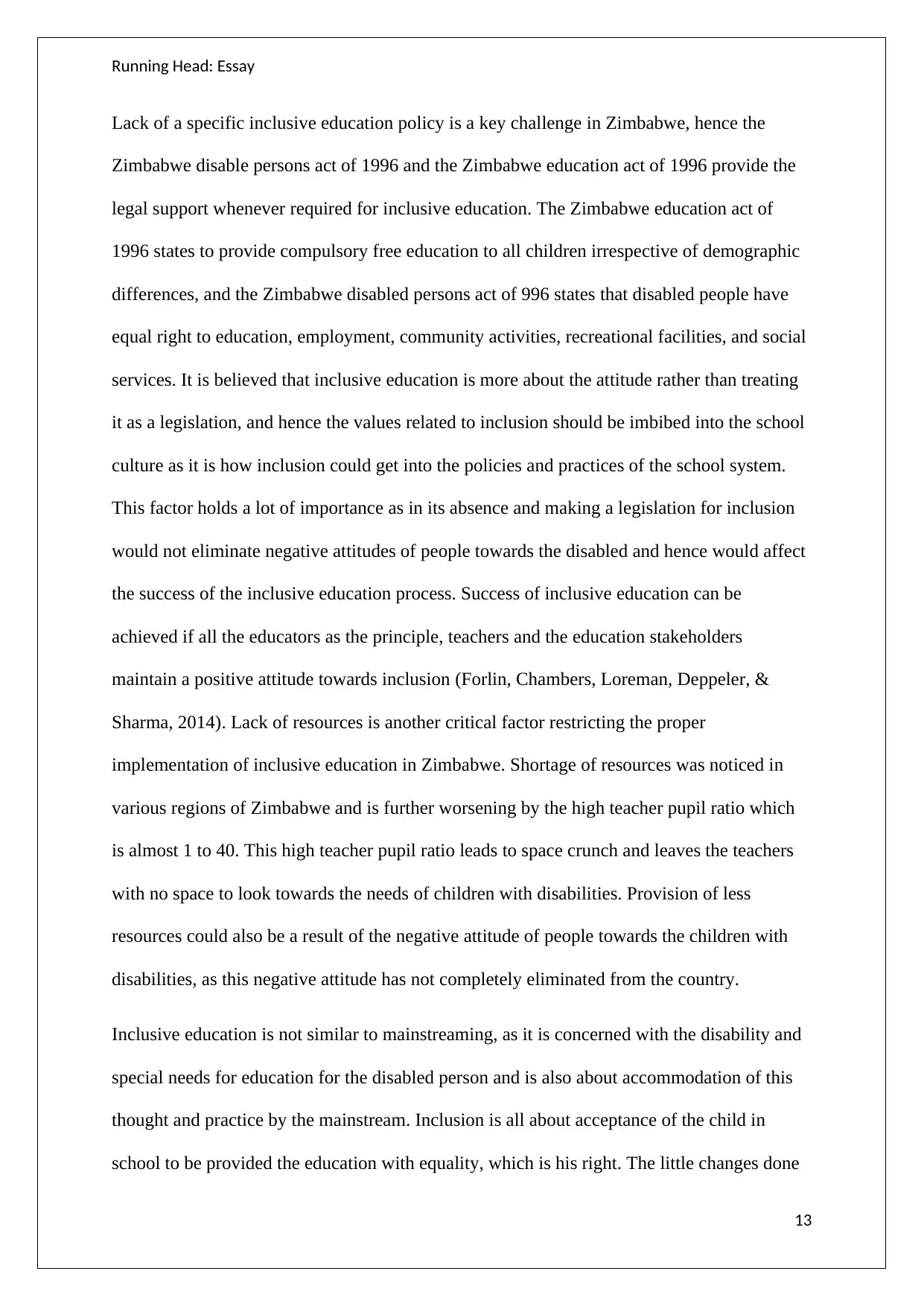
Running Head: Essay
Lack of a specific inclusive education policy is a key challenge in Zimbabwe, hence the
Zimbabwe disable persons act of 1996 and the Zimbabwe education act of 1996 provide the
legal support whenever required for inclusive education. The Zimbabwe education act of
1996 states to provide compulsory free education to all children irrespective of demographic
differences, and the Zimbabwe disabled persons act of 996 states that disabled people have
equal right to education, employment, community activities, recreational facilities, and social
services. It is believed that inclusive education is more about the attitude rather than treating
it as a legislation, and hence the values related to inclusion should be imbibed into the school
culture as it is how inclusion could get into the policies and practices of the school system.
This factor holds a lot of importance as in its absence and making a legislation for inclusion
would not eliminate negative attitudes of people towards the disabled and hence would affect
the success of the inclusive education process. Success of inclusive education can be
achieved if all the educators as the principle, teachers and the education stakeholders
maintain a positive attitude towards inclusion (Forlin, Chambers, Loreman, Deppeler, &
Sharma, 2014). Lack of resources is another critical factor restricting the proper
implementation of inclusive education in Zimbabwe. Shortage of resources was noticed in
various regions of Zimbabwe and is further worsening by the high teacher pupil ratio which
is almost 1 to 40. This high teacher pupil ratio leads to space crunch and leaves the teachers
with no space to look towards the needs of children with disabilities. Provision of less
resources could also be a result of the negative attitude of people towards the children with
disabilities, as this negative attitude has not completely eliminated from the country.
Inclusive education is not similar to mainstreaming, as it is concerned with the disability and
special needs for education for the disabled person and is also about accommodation of this
thought and practice by the mainstream. Inclusion is all about acceptance of the child in
school to be provided the education with equality, which is his right. The little changes done
13
Lack of a specific inclusive education policy is a key challenge in Zimbabwe, hence the
Zimbabwe disable persons act of 1996 and the Zimbabwe education act of 1996 provide the
legal support whenever required for inclusive education. The Zimbabwe education act of
1996 states to provide compulsory free education to all children irrespective of demographic
differences, and the Zimbabwe disabled persons act of 996 states that disabled people have
equal right to education, employment, community activities, recreational facilities, and social
services. It is believed that inclusive education is more about the attitude rather than treating
it as a legislation, and hence the values related to inclusion should be imbibed into the school
culture as it is how inclusion could get into the policies and practices of the school system.
This factor holds a lot of importance as in its absence and making a legislation for inclusion
would not eliminate negative attitudes of people towards the disabled and hence would affect
the success of the inclusive education process. Success of inclusive education can be
achieved if all the educators as the principle, teachers and the education stakeholders
maintain a positive attitude towards inclusion (Forlin, Chambers, Loreman, Deppeler, &
Sharma, 2014). Lack of resources is another critical factor restricting the proper
implementation of inclusive education in Zimbabwe. Shortage of resources was noticed in
various regions of Zimbabwe and is further worsening by the high teacher pupil ratio which
is almost 1 to 40. This high teacher pupil ratio leads to space crunch and leaves the teachers
with no space to look towards the needs of children with disabilities. Provision of less
resources could also be a result of the negative attitude of people towards the children with
disabilities, as this negative attitude has not completely eliminated from the country.
Inclusive education is not similar to mainstreaming, as it is concerned with the disability and
special needs for education for the disabled person and is also about accommodation of this
thought and practice by the mainstream. Inclusion is all about acceptance of the child in
school to be provided the education with equality, which is his right. The little changes done
13
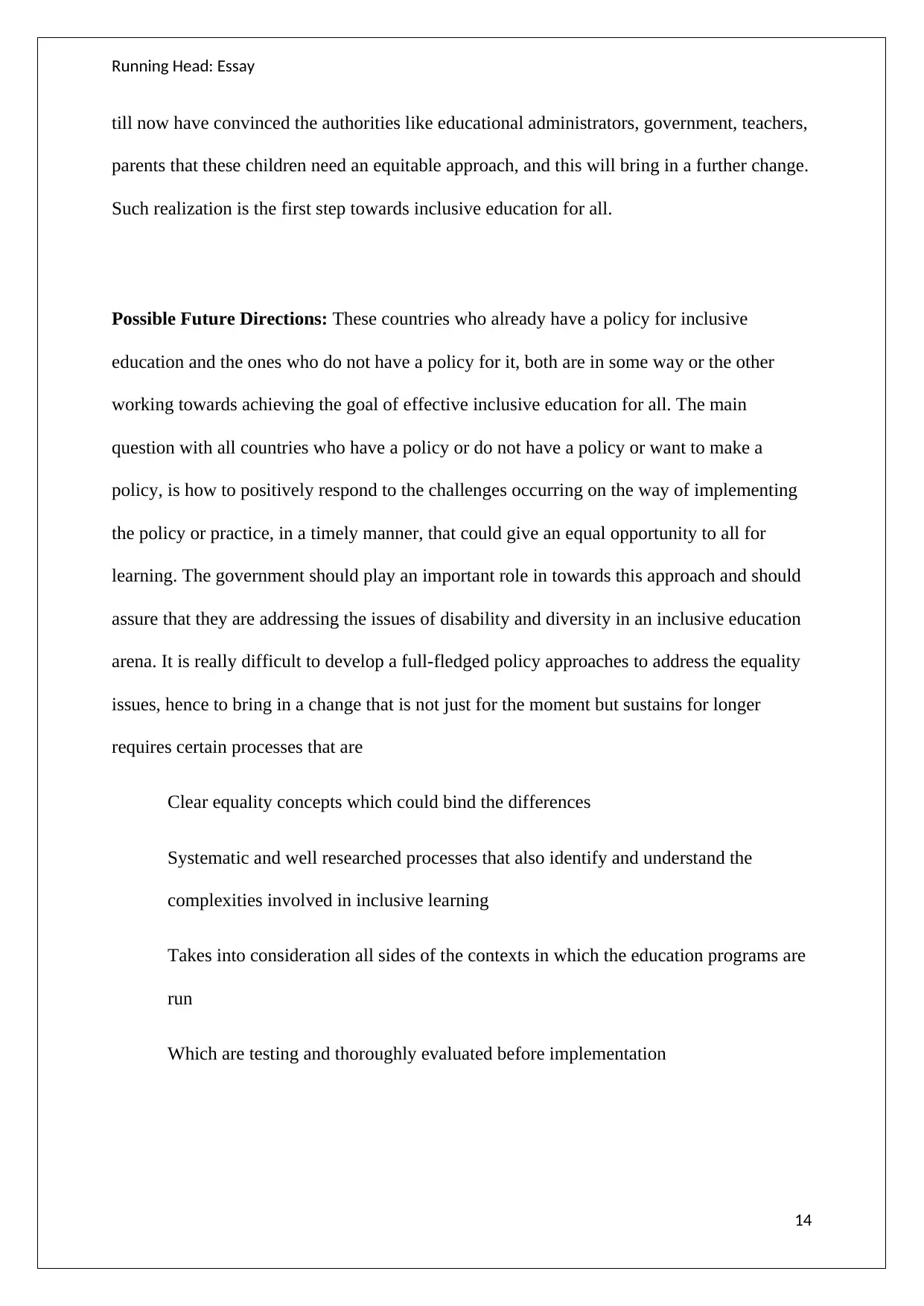
Running Head: Essay
till now have convinced the authorities like educational administrators, government, teachers,
parents that these children need an equitable approach, and this will bring in a further change.
Such realization is the first step towards inclusive education for all.
Possible Future Directions: These countries who already have a policy for inclusive
education and the ones who do not have a policy for it, both are in some way or the other
working towards achieving the goal of effective inclusive education for all. The main
question with all countries who have a policy or do not have a policy or want to make a
policy, is how to positively respond to the challenges occurring on the way of implementing
the policy or practice, in a timely manner, that could give an equal opportunity to all for
learning. The government should play an important role in towards this approach and should
assure that they are addressing the issues of disability and diversity in an inclusive education
arena. It is really difficult to develop a full-fledged policy approaches to address the equality
issues, hence to bring in a change that is not just for the moment but sustains for longer
requires certain processes that are
Clear equality concepts which could bind the differences
Systematic and well researched processes that also identify and understand the
complexities involved in inclusive learning
Takes into consideration all sides of the contexts in which the education programs are
run
Which are testing and thoroughly evaluated before implementation
14
till now have convinced the authorities like educational administrators, government, teachers,
parents that these children need an equitable approach, and this will bring in a further change.
Such realization is the first step towards inclusive education for all.
Possible Future Directions: These countries who already have a policy for inclusive
education and the ones who do not have a policy for it, both are in some way or the other
working towards achieving the goal of effective inclusive education for all. The main
question with all countries who have a policy or do not have a policy or want to make a
policy, is how to positively respond to the challenges occurring on the way of implementing
the policy or practice, in a timely manner, that could give an equal opportunity to all for
learning. The government should play an important role in towards this approach and should
assure that they are addressing the issues of disability and diversity in an inclusive education
arena. It is really difficult to develop a full-fledged policy approaches to address the equality
issues, hence to bring in a change that is not just for the moment but sustains for longer
requires certain processes that are
Clear equality concepts which could bind the differences
Systematic and well researched processes that also identify and understand the
complexities involved in inclusive learning
Takes into consideration all sides of the contexts in which the education programs are
run
Which are testing and thoroughly evaluated before implementation
14
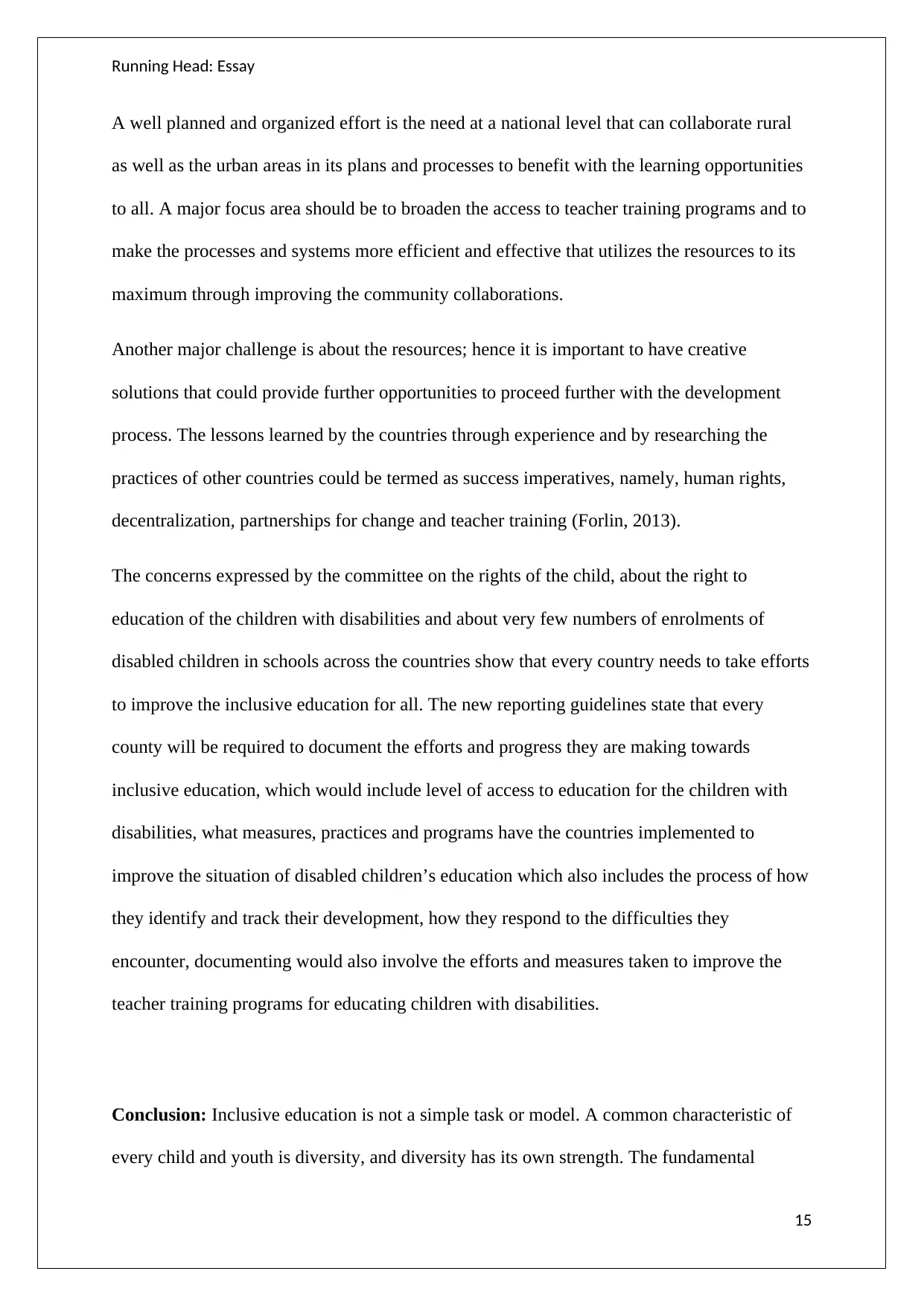
Running Head: Essay
A well planned and organized effort is the need at a national level that can collaborate rural
as well as the urban areas in its plans and processes to benefit with the learning opportunities
to all. A major focus area should be to broaden the access to teacher training programs and to
make the processes and systems more efficient and effective that utilizes the resources to its
maximum through improving the community collaborations.
Another major challenge is about the resources; hence it is important to have creative
solutions that could provide further opportunities to proceed further with the development
process. The lessons learned by the countries through experience and by researching the
practices of other countries could be termed as success imperatives, namely, human rights,
decentralization, partnerships for change and teacher training (Forlin, 2013).
The concerns expressed by the committee on the rights of the child, about the right to
education of the children with disabilities and about very few numbers of enrolments of
disabled children in schools across the countries show that every country needs to take efforts
to improve the inclusive education for all. The new reporting guidelines state that every
county will be required to document the efforts and progress they are making towards
inclusive education, which would include level of access to education for the children with
disabilities, what measures, practices and programs have the countries implemented to
improve the situation of disabled children’s education which also includes the process of how
they identify and track their development, how they respond to the difficulties they
encounter, documenting would also involve the efforts and measures taken to improve the
teacher training programs for educating children with disabilities.
Conclusion: Inclusive education is not a simple task or model. A common characteristic of
every child and youth is diversity, and diversity has its own strength. The fundamental
15
A well planned and organized effort is the need at a national level that can collaborate rural
as well as the urban areas in its plans and processes to benefit with the learning opportunities
to all. A major focus area should be to broaden the access to teacher training programs and to
make the processes and systems more efficient and effective that utilizes the resources to its
maximum through improving the community collaborations.
Another major challenge is about the resources; hence it is important to have creative
solutions that could provide further opportunities to proceed further with the development
process. The lessons learned by the countries through experience and by researching the
practices of other countries could be termed as success imperatives, namely, human rights,
decentralization, partnerships for change and teacher training (Forlin, 2013).
The concerns expressed by the committee on the rights of the child, about the right to
education of the children with disabilities and about very few numbers of enrolments of
disabled children in schools across the countries show that every country needs to take efforts
to improve the inclusive education for all. The new reporting guidelines state that every
county will be required to document the efforts and progress they are making towards
inclusive education, which would include level of access to education for the children with
disabilities, what measures, practices and programs have the countries implemented to
improve the situation of disabled children’s education which also includes the process of how
they identify and track their development, how they respond to the difficulties they
encounter, documenting would also involve the efforts and measures taken to improve the
teacher training programs for educating children with disabilities.
Conclusion: Inclusive education is not a simple task or model. A common characteristic of
every child and youth is diversity, and diversity has its own strength. The fundamental
15
Secure Best Marks with AI Grader
Need help grading? Try our AI Grader for instant feedback on your assignments.
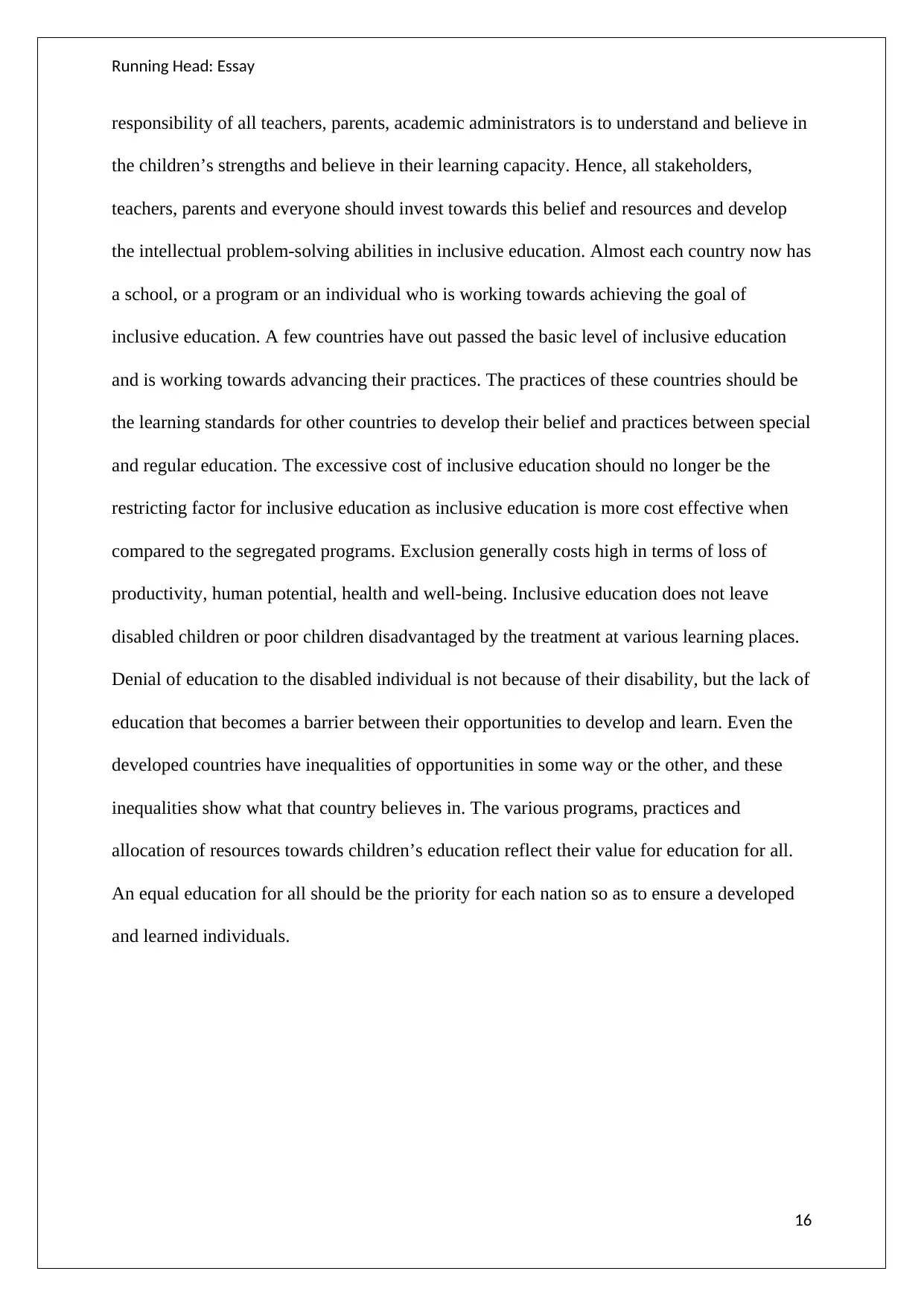
Running Head: Essay
responsibility of all teachers, parents, academic administrators is to understand and believe in
the children’s strengths and believe in their learning capacity. Hence, all stakeholders,
teachers, parents and everyone should invest towards this belief and resources and develop
the intellectual problem-solving abilities in inclusive education. Almost each country now has
a school, or a program or an individual who is working towards achieving the goal of
inclusive education. A few countries have out passed the basic level of inclusive education
and is working towards advancing their practices. The practices of these countries should be
the learning standards for other countries to develop their belief and practices between special
and regular education. The excessive cost of inclusive education should no longer be the
restricting factor for inclusive education as inclusive education is more cost effective when
compared to the segregated programs. Exclusion generally costs high in terms of loss of
productivity, human potential, health and well-being. Inclusive education does not leave
disabled children or poor children disadvantaged by the treatment at various learning places.
Denial of education to the disabled individual is not because of their disability, but the lack of
education that becomes a barrier between their opportunities to develop and learn. Even the
developed countries have inequalities of opportunities in some way or the other, and these
inequalities show what that country believes in. The various programs, practices and
allocation of resources towards children’s education reflect their value for education for all.
An equal education for all should be the priority for each nation so as to ensure a developed
and learned individuals.
16
responsibility of all teachers, parents, academic administrators is to understand and believe in
the children’s strengths and believe in their learning capacity. Hence, all stakeholders,
teachers, parents and everyone should invest towards this belief and resources and develop
the intellectual problem-solving abilities in inclusive education. Almost each country now has
a school, or a program or an individual who is working towards achieving the goal of
inclusive education. A few countries have out passed the basic level of inclusive education
and is working towards advancing their practices. The practices of these countries should be
the learning standards for other countries to develop their belief and practices between special
and regular education. The excessive cost of inclusive education should no longer be the
restricting factor for inclusive education as inclusive education is more cost effective when
compared to the segregated programs. Exclusion generally costs high in terms of loss of
productivity, human potential, health and well-being. Inclusive education does not leave
disabled children or poor children disadvantaged by the treatment at various learning places.
Denial of education to the disabled individual is not because of their disability, but the lack of
education that becomes a barrier between their opportunities to develop and learn. Even the
developed countries have inequalities of opportunities in some way or the other, and these
inequalities show what that country believes in. The various programs, practices and
allocation of resources towards children’s education reflect their value for education for all.
An equal education for all should be the priority for each nation so as to ensure a developed
and learned individuals.
16
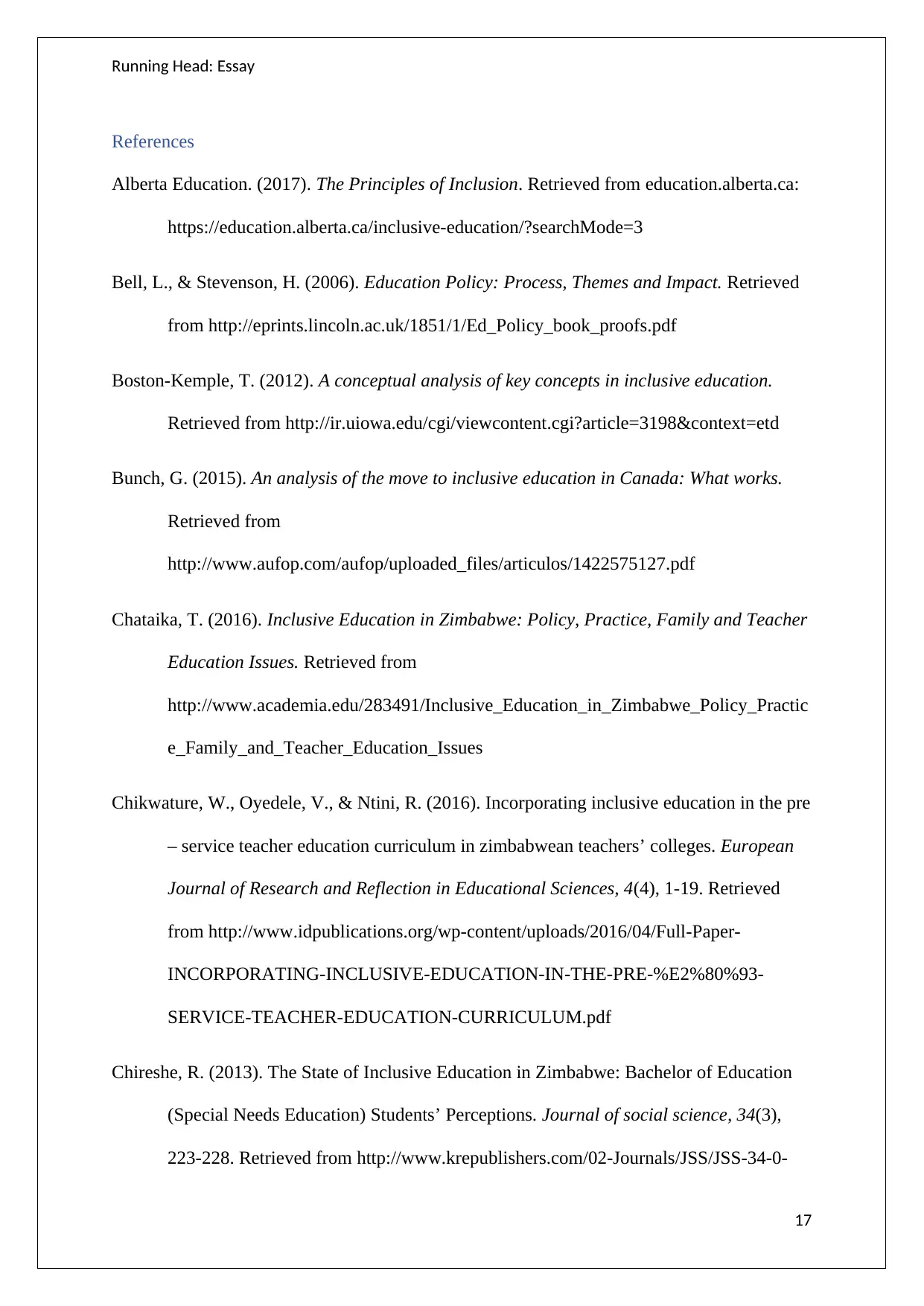
Running Head: Essay
References
Alberta Education. (2017). The Principles of Inclusion. Retrieved from education.alberta.ca:
https://education.alberta.ca/inclusive-education/?searchMode=3
Bell, L., & Stevenson, H. (2006). Education Policy: Process, Themes and Impact. Retrieved
from http://eprints.lincoln.ac.uk/1851/1/Ed_Policy_book_proofs.pdf
Boston-Kemple, T. (2012). A conceptual analysis of key concepts in inclusive education.
Retrieved from http://ir.uiowa.edu/cgi/viewcontent.cgi?article=3198&context=etd
Bunch, G. (2015). An analysis of the move to inclusive education in Canada: What works.
Retrieved from
http://www.aufop.com/aufop/uploaded_files/articulos/1422575127.pdf
Chataika, T. (2016). Inclusive Education in Zimbabwe: Policy, Practice, Family and Teacher
Education Issues. Retrieved from
http://www.academia.edu/283491/Inclusive_Education_in_Zimbabwe_Policy_Practic
e_Family_and_Teacher_Education_Issues
Chikwature, W., Oyedele, V., & Ntini, R. (2016). Incorporating inclusive education in the pre
– service teacher education curriculum in zimbabwean teachers’ colleges. European
Journal of Research and Reflection in Educational Sciences, 4(4), 1-19. Retrieved
from http://www.idpublications.org/wp-content/uploads/2016/04/Full-Paper-
INCORPORATING-INCLUSIVE-EDUCATION-IN-THE-PRE-%E2%80%93-
SERVICE-TEACHER-EDUCATION-CURRICULUM.pdf
Chireshe, R. (2013). The State of Inclusive Education in Zimbabwe: Bachelor of Education
(Special Needs Education) Students’ Perceptions. Journal of social science, 34(3),
223-228. Retrieved from http://www.krepublishers.com/02-Journals/JSS/JSS-34-0-
17
References
Alberta Education. (2017). The Principles of Inclusion. Retrieved from education.alberta.ca:
https://education.alberta.ca/inclusive-education/?searchMode=3
Bell, L., & Stevenson, H. (2006). Education Policy: Process, Themes and Impact. Retrieved
from http://eprints.lincoln.ac.uk/1851/1/Ed_Policy_book_proofs.pdf
Boston-Kemple, T. (2012). A conceptual analysis of key concepts in inclusive education.
Retrieved from http://ir.uiowa.edu/cgi/viewcontent.cgi?article=3198&context=etd
Bunch, G. (2015). An analysis of the move to inclusive education in Canada: What works.
Retrieved from
http://www.aufop.com/aufop/uploaded_files/articulos/1422575127.pdf
Chataika, T. (2016). Inclusive Education in Zimbabwe: Policy, Practice, Family and Teacher
Education Issues. Retrieved from
http://www.academia.edu/283491/Inclusive_Education_in_Zimbabwe_Policy_Practic
e_Family_and_Teacher_Education_Issues
Chikwature, W., Oyedele, V., & Ntini, R. (2016). Incorporating inclusive education in the pre
– service teacher education curriculum in zimbabwean teachers’ colleges. European
Journal of Research and Reflection in Educational Sciences, 4(4), 1-19. Retrieved
from http://www.idpublications.org/wp-content/uploads/2016/04/Full-Paper-
INCORPORATING-INCLUSIVE-EDUCATION-IN-THE-PRE-%E2%80%93-
SERVICE-TEACHER-EDUCATION-CURRICULUM.pdf
Chireshe, R. (2013). The State of Inclusive Education in Zimbabwe: Bachelor of Education
(Special Needs Education) Students’ Perceptions. Journal of social science, 34(3),
223-228. Retrieved from http://www.krepublishers.com/02-Journals/JSS/JSS-34-0-
17
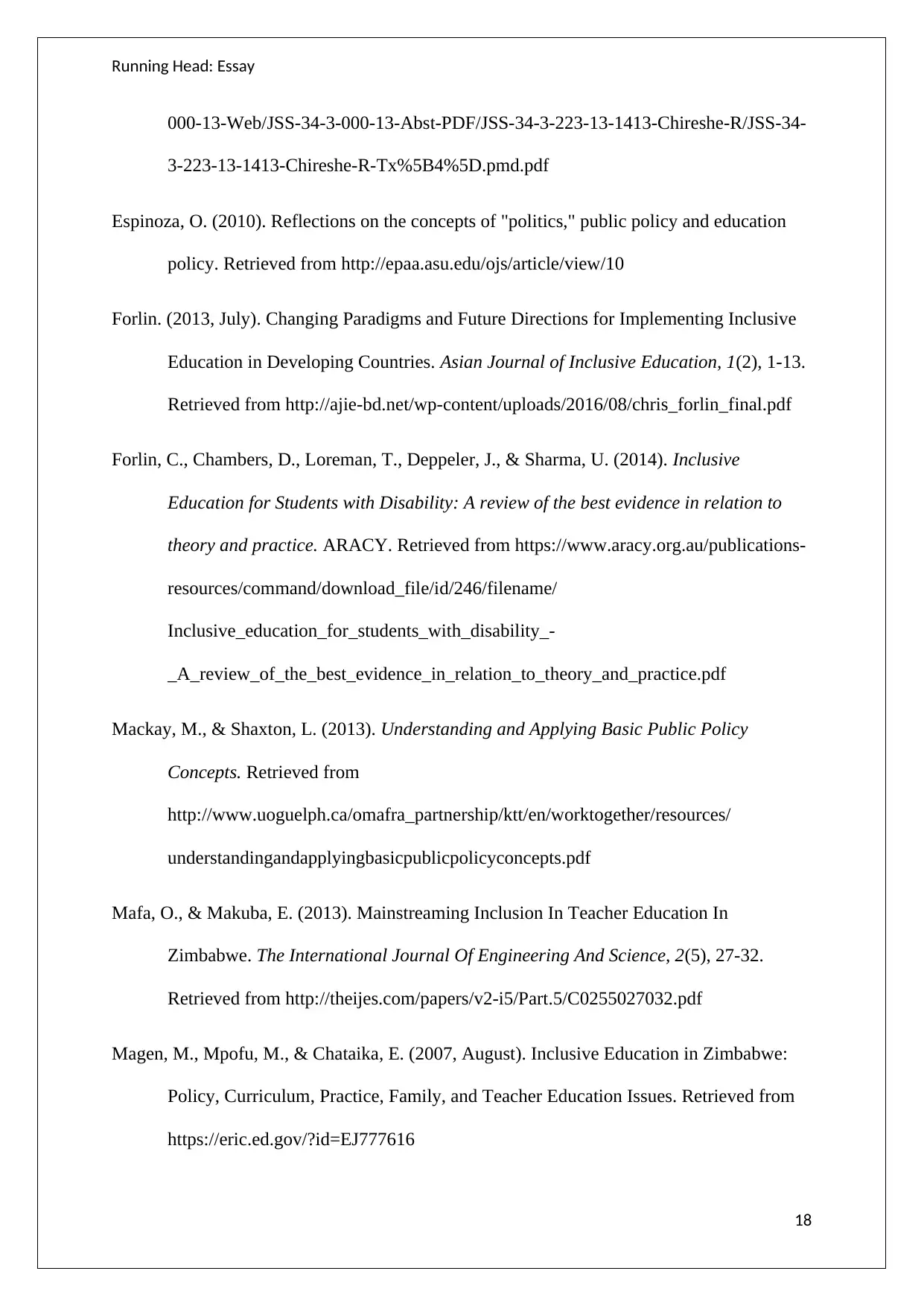
Running Head: Essay
000-13-Web/JSS-34-3-000-13-Abst-PDF/JSS-34-3-223-13-1413-Chireshe-R/JSS-34-
3-223-13-1413-Chireshe-R-Tx%5B4%5D.pmd.pdf
Espinoza, O. (2010). Reflections on the concepts of "politics," public policy and education
policy. Retrieved from http://epaa.asu.edu/ojs/article/view/10
Forlin. (2013, July). Changing Paradigms and Future Directions for Implementing Inclusive
Education in Developing Countries. Asian Journal of Inclusive Education, 1(2), 1-13.
Retrieved from http://ajie-bd.net/wp-content/uploads/2016/08/chris_forlin_final.pdf
Forlin, C., Chambers, D., Loreman, T., Deppeler, J., & Sharma, U. (2014). Inclusive
Education for Students with Disability: A review of the best evidence in relation to
theory and practice. ARACY. Retrieved from https://www.aracy.org.au/publications-
resources/command/download_file/id/246/filename/
Inclusive_education_for_students_with_disability_-
_A_review_of_the_best_evidence_in_relation_to_theory_and_practice.pdf
Mackay, M., & Shaxton, L. (2013). Understanding and Applying Basic Public Policy
Concepts. Retrieved from
http://www.uoguelph.ca/omafra_partnership/ktt/en/worktogether/resources/
understandingandapplyingbasicpublicpolicyconcepts.pdf
Mafa, O., & Makuba, E. (2013). Mainstreaming Inclusion In Teacher Education In
Zimbabwe. The International Journal Of Engineering And Science, 2(5), 27-32.
Retrieved from http://theijes.com/papers/v2-i5/Part.5/C0255027032.pdf
Magen, M., Mpofu, M., & Chataika, E. (2007, August). Inclusive Education in Zimbabwe:
Policy, Curriculum, Practice, Family, and Teacher Education Issues. Retrieved from
https://eric.ed.gov/?id=EJ777616
18
000-13-Web/JSS-34-3-000-13-Abst-PDF/JSS-34-3-223-13-1413-Chireshe-R/JSS-34-
3-223-13-1413-Chireshe-R-Tx%5B4%5D.pmd.pdf
Espinoza, O. (2010). Reflections on the concepts of "politics," public policy and education
policy. Retrieved from http://epaa.asu.edu/ojs/article/view/10
Forlin. (2013, July). Changing Paradigms and Future Directions for Implementing Inclusive
Education in Developing Countries. Asian Journal of Inclusive Education, 1(2), 1-13.
Retrieved from http://ajie-bd.net/wp-content/uploads/2016/08/chris_forlin_final.pdf
Forlin, C., Chambers, D., Loreman, T., Deppeler, J., & Sharma, U. (2014). Inclusive
Education for Students with Disability: A review of the best evidence in relation to
theory and practice. ARACY. Retrieved from https://www.aracy.org.au/publications-
resources/command/download_file/id/246/filename/
Inclusive_education_for_students_with_disability_-
_A_review_of_the_best_evidence_in_relation_to_theory_and_practice.pdf
Mackay, M., & Shaxton, L. (2013). Understanding and Applying Basic Public Policy
Concepts. Retrieved from
http://www.uoguelph.ca/omafra_partnership/ktt/en/worktogether/resources/
understandingandapplyingbasicpublicpolicyconcepts.pdf
Mafa, O., & Makuba, E. (2013). Mainstreaming Inclusion In Teacher Education In
Zimbabwe. The International Journal Of Engineering And Science, 2(5), 27-32.
Retrieved from http://theijes.com/papers/v2-i5/Part.5/C0255027032.pdf
Magen, M., Mpofu, M., & Chataika, E. (2007, August). Inclusive Education in Zimbabwe:
Policy, Curriculum, Practice, Family, and Teacher Education Issues. Retrieved from
https://eric.ed.gov/?id=EJ777616
18
Paraphrase This Document
Need a fresh take? Get an instant paraphrase of this document with our AI Paraphraser
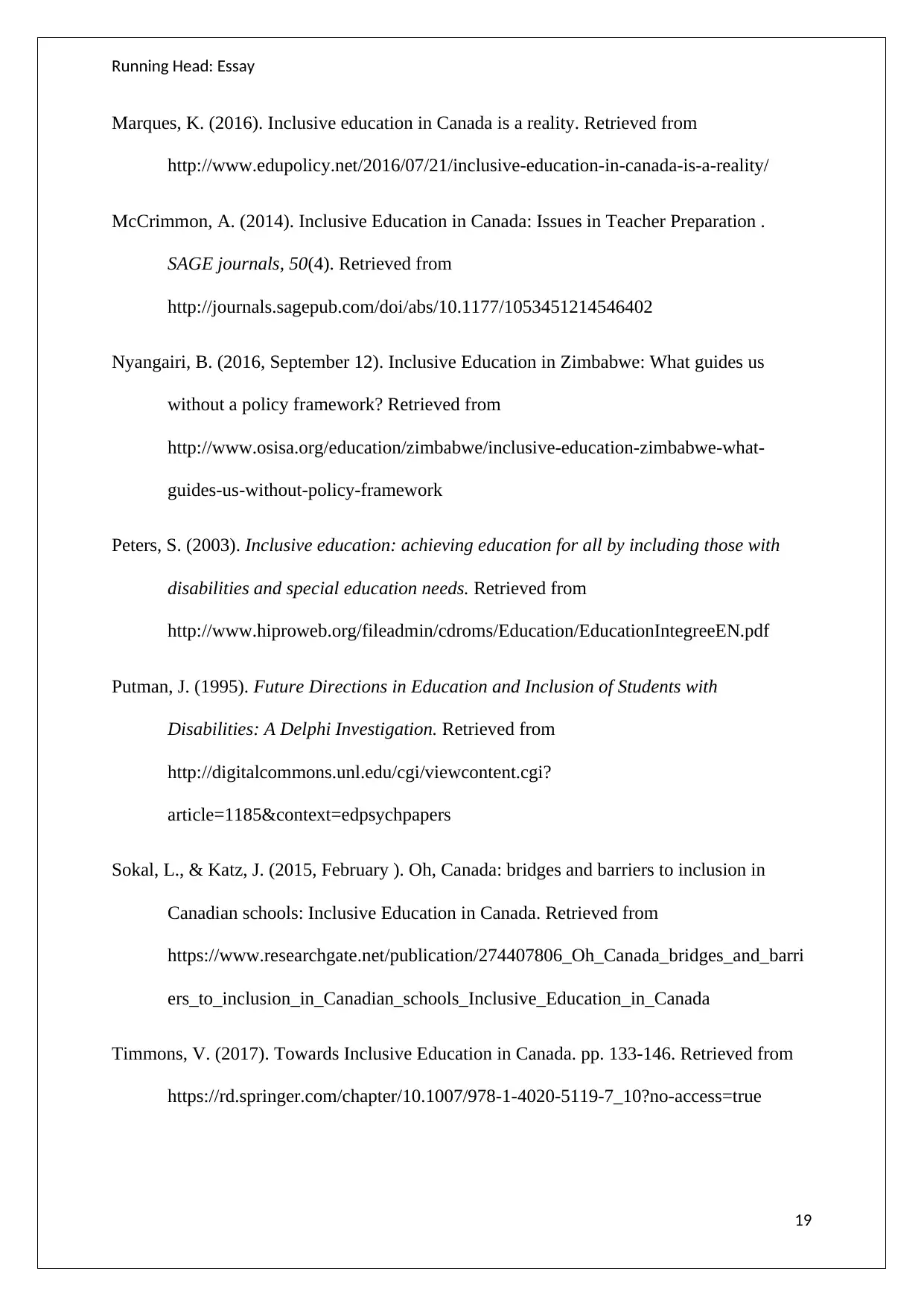
Running Head: Essay
Marques, K. (2016). Inclusive education in Canada is a reality. Retrieved from
http://www.edupolicy.net/2016/07/21/inclusive-education-in-canada-is-a-reality/
McCrimmon, A. (2014). Inclusive Education in Canada: Issues in Teacher Preparation .
SAGE journals, 50(4). Retrieved from
http://journals.sagepub.com/doi/abs/10.1177/1053451214546402
Nyangairi, B. (2016, September 12). Inclusive Education in Zimbabwe: What guides us
without a policy framework? Retrieved from
http://www.osisa.org/education/zimbabwe/inclusive-education-zimbabwe-what-
guides-us-without-policy-framework
Peters, S. (2003). Inclusive education: achieving education for all by including those with
disabilities and special education needs. Retrieved from
http://www.hiproweb.org/fileadmin/cdroms/Education/EducationIntegreeEN.pdf
Putman, J. (1995). Future Directions in Education and Inclusion of Students with
Disabilities: A Delphi Investigation. Retrieved from
http://digitalcommons.unl.edu/cgi/viewcontent.cgi?
article=1185&context=edpsychpapers
Sokal, L., & Katz, J. (2015, February ). Oh, Canada: bridges and barriers to inclusion in
Canadian schools: Inclusive Education in Canada. Retrieved from
https://www.researchgate.net/publication/274407806_Oh_Canada_bridges_and_barri
ers_to_inclusion_in_Canadian_schools_Inclusive_Education_in_Canada
Timmons, V. (2017). Towards Inclusive Education in Canada. pp. 133-146. Retrieved from
https://rd.springer.com/chapter/10.1007/978-1-4020-5119-7_10?no-access=true
19
Marques, K. (2016). Inclusive education in Canada is a reality. Retrieved from
http://www.edupolicy.net/2016/07/21/inclusive-education-in-canada-is-a-reality/
McCrimmon, A. (2014). Inclusive Education in Canada: Issues in Teacher Preparation .
SAGE journals, 50(4). Retrieved from
http://journals.sagepub.com/doi/abs/10.1177/1053451214546402
Nyangairi, B. (2016, September 12). Inclusive Education in Zimbabwe: What guides us
without a policy framework? Retrieved from
http://www.osisa.org/education/zimbabwe/inclusive-education-zimbabwe-what-
guides-us-without-policy-framework
Peters, S. (2003). Inclusive education: achieving education for all by including those with
disabilities and special education needs. Retrieved from
http://www.hiproweb.org/fileadmin/cdroms/Education/EducationIntegreeEN.pdf
Putman, J. (1995). Future Directions in Education and Inclusion of Students with
Disabilities: A Delphi Investigation. Retrieved from
http://digitalcommons.unl.edu/cgi/viewcontent.cgi?
article=1185&context=edpsychpapers
Sokal, L., & Katz, J. (2015, February ). Oh, Canada: bridges and barriers to inclusion in
Canadian schools: Inclusive Education in Canada. Retrieved from
https://www.researchgate.net/publication/274407806_Oh_Canada_bridges_and_barri
ers_to_inclusion_in_Canadian_schools_Inclusive_Education_in_Canada
Timmons, V. (2017). Towards Inclusive Education in Canada. pp. 133-146. Retrieved from
https://rd.springer.com/chapter/10.1007/978-1-4020-5119-7_10?no-access=true
19
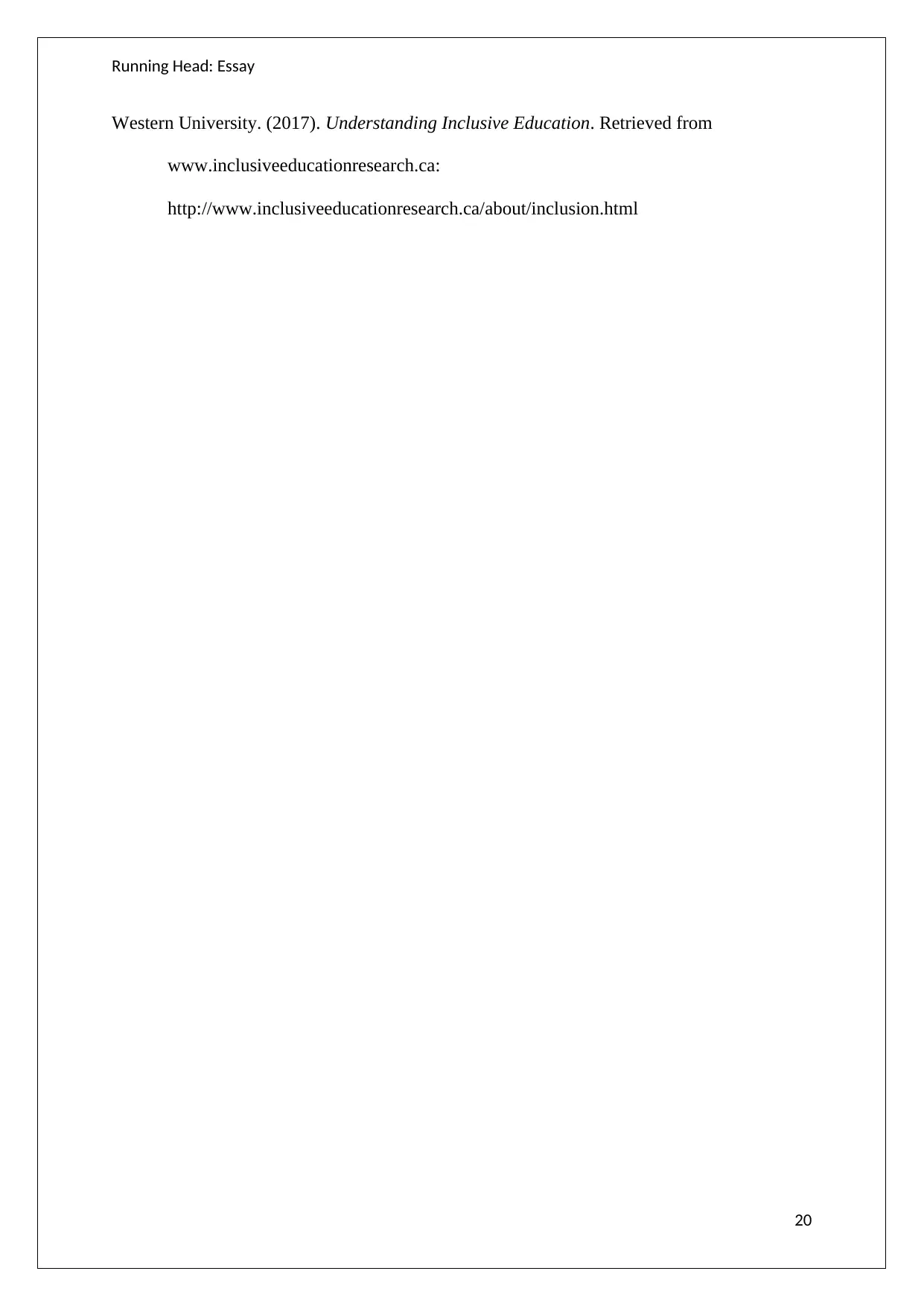
Running Head: Essay
Western University. (2017). Understanding Inclusive Education. Retrieved from
www.inclusiveeducationresearch.ca:
http://www.inclusiveeducationresearch.ca/about/inclusion.html
20
Western University. (2017). Understanding Inclusive Education. Retrieved from
www.inclusiveeducationresearch.ca:
http://www.inclusiveeducationresearch.ca/about/inclusion.html
20
1 out of 21
Related Documents
Your All-in-One AI-Powered Toolkit for Academic Success.
+13062052269
info@desklib.com
Available 24*7 on WhatsApp / Email
![[object Object]](/_next/static/media/star-bottom.7253800d.svg)
Unlock your academic potential
© 2024 | Zucol Services PVT LTD | All rights reserved.




